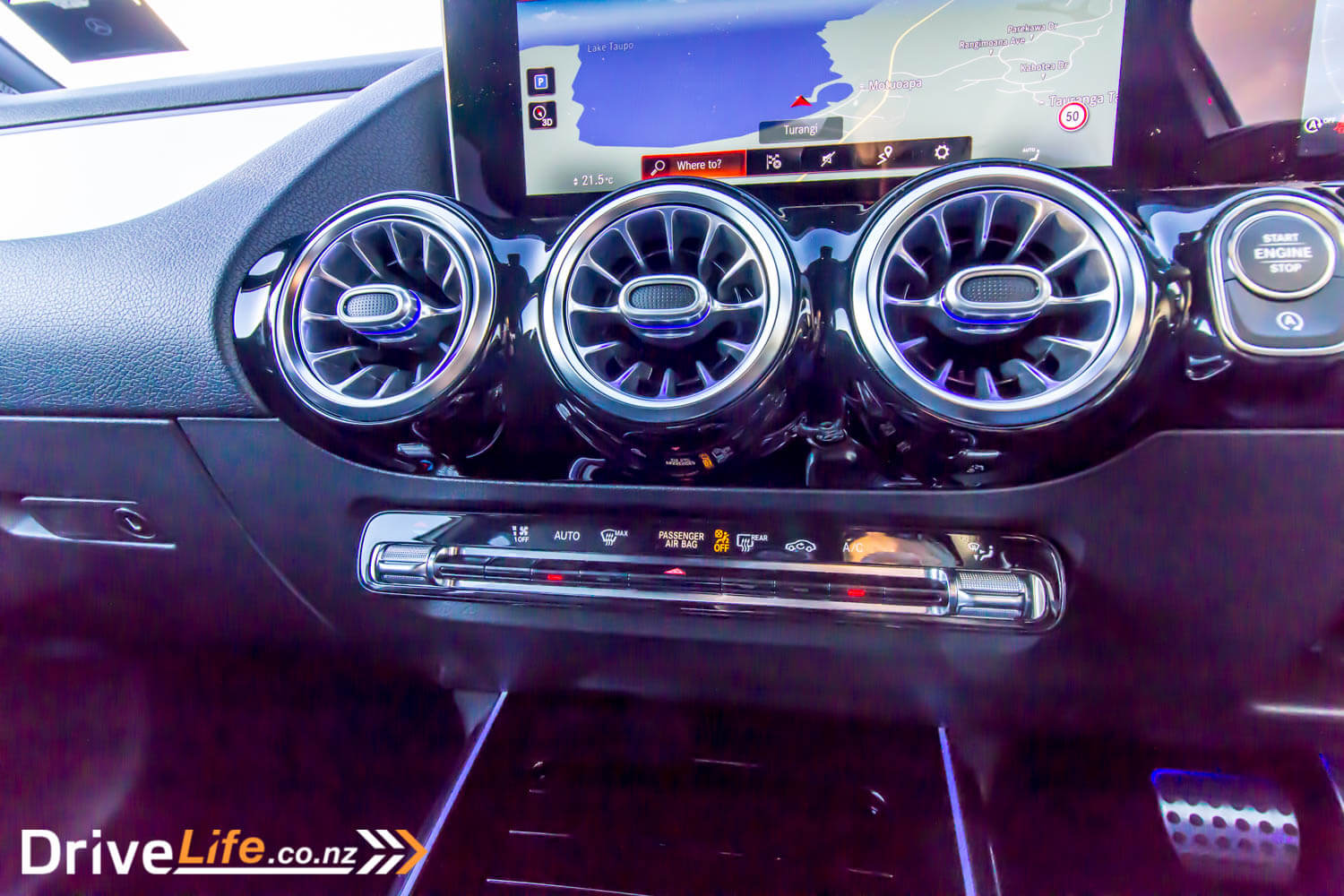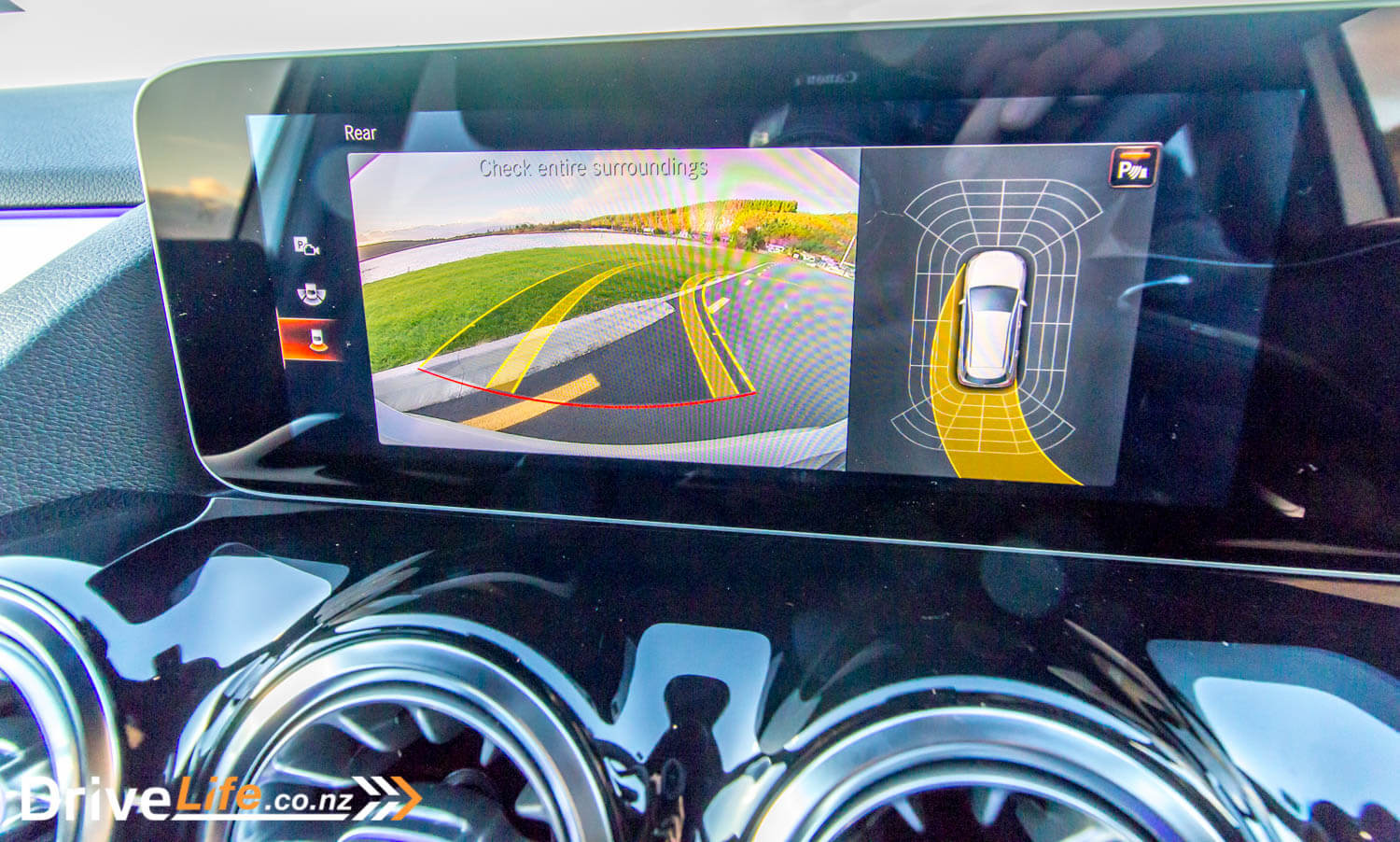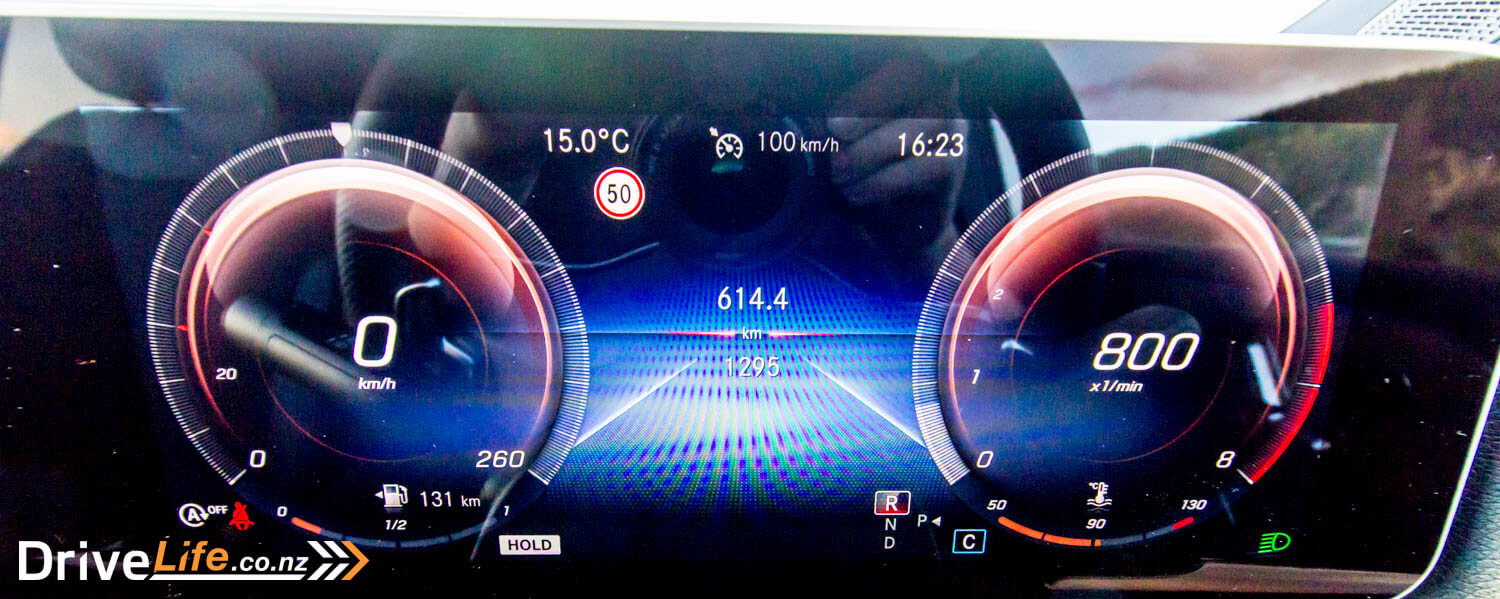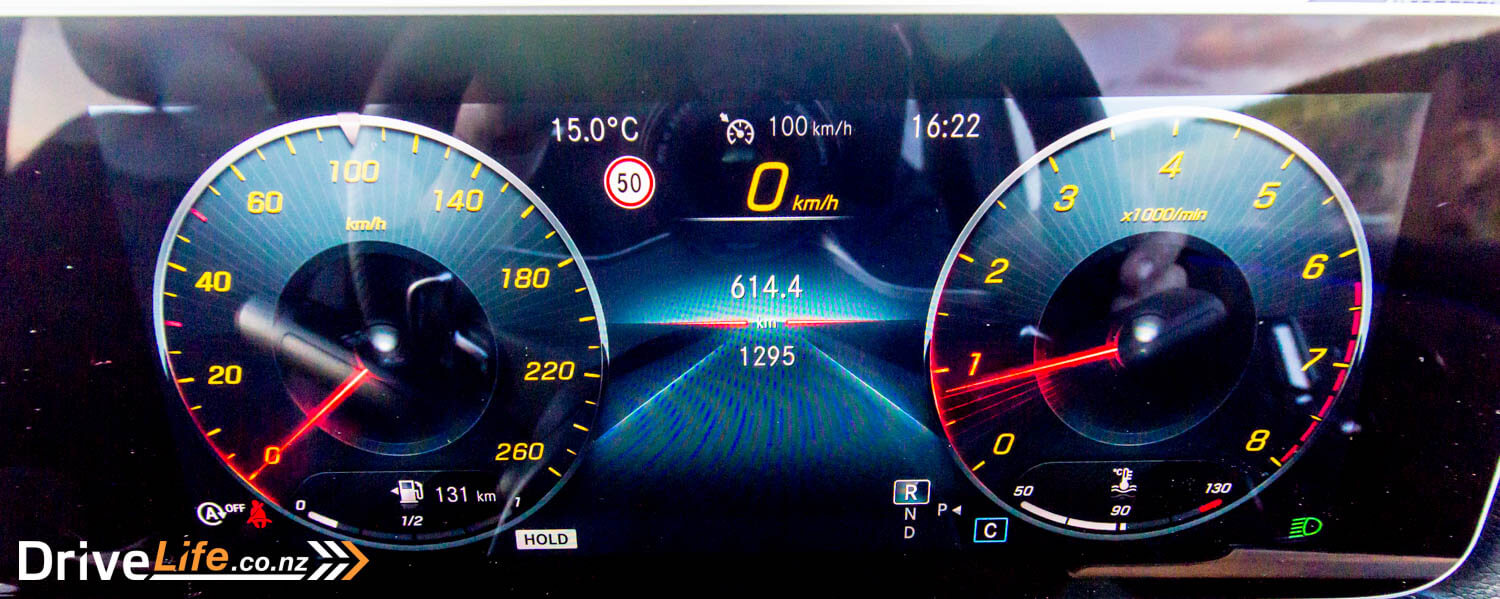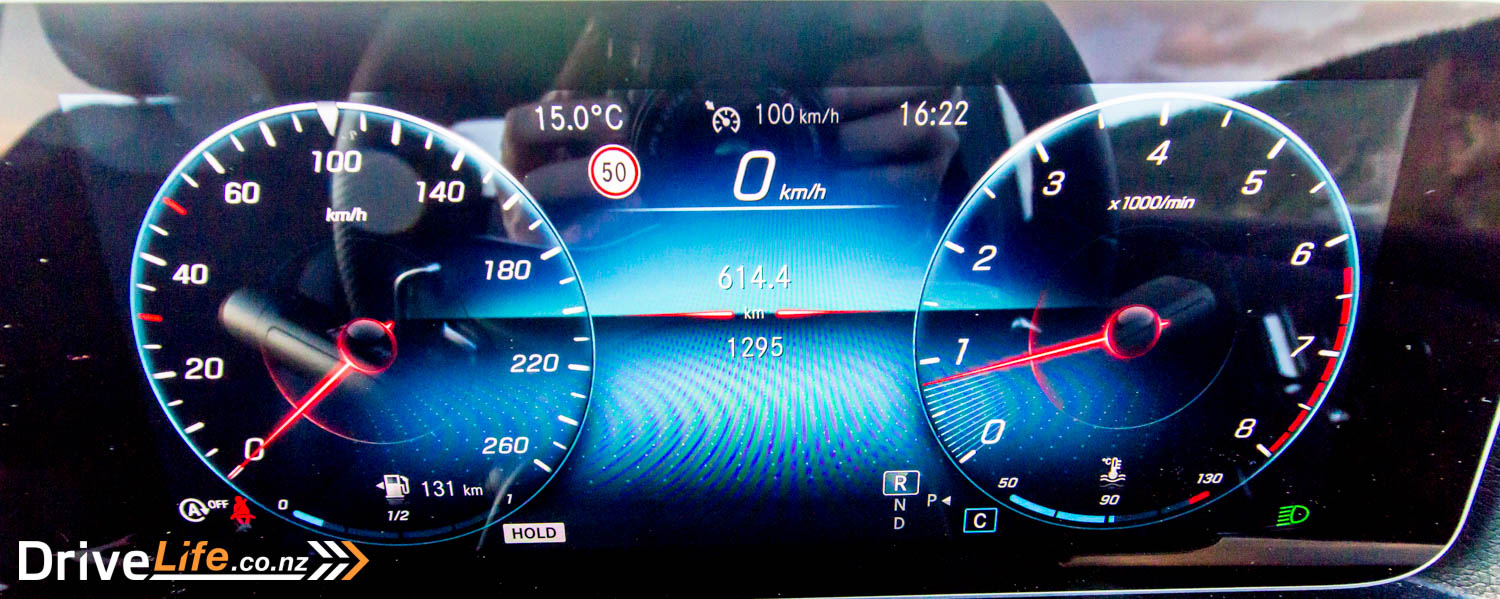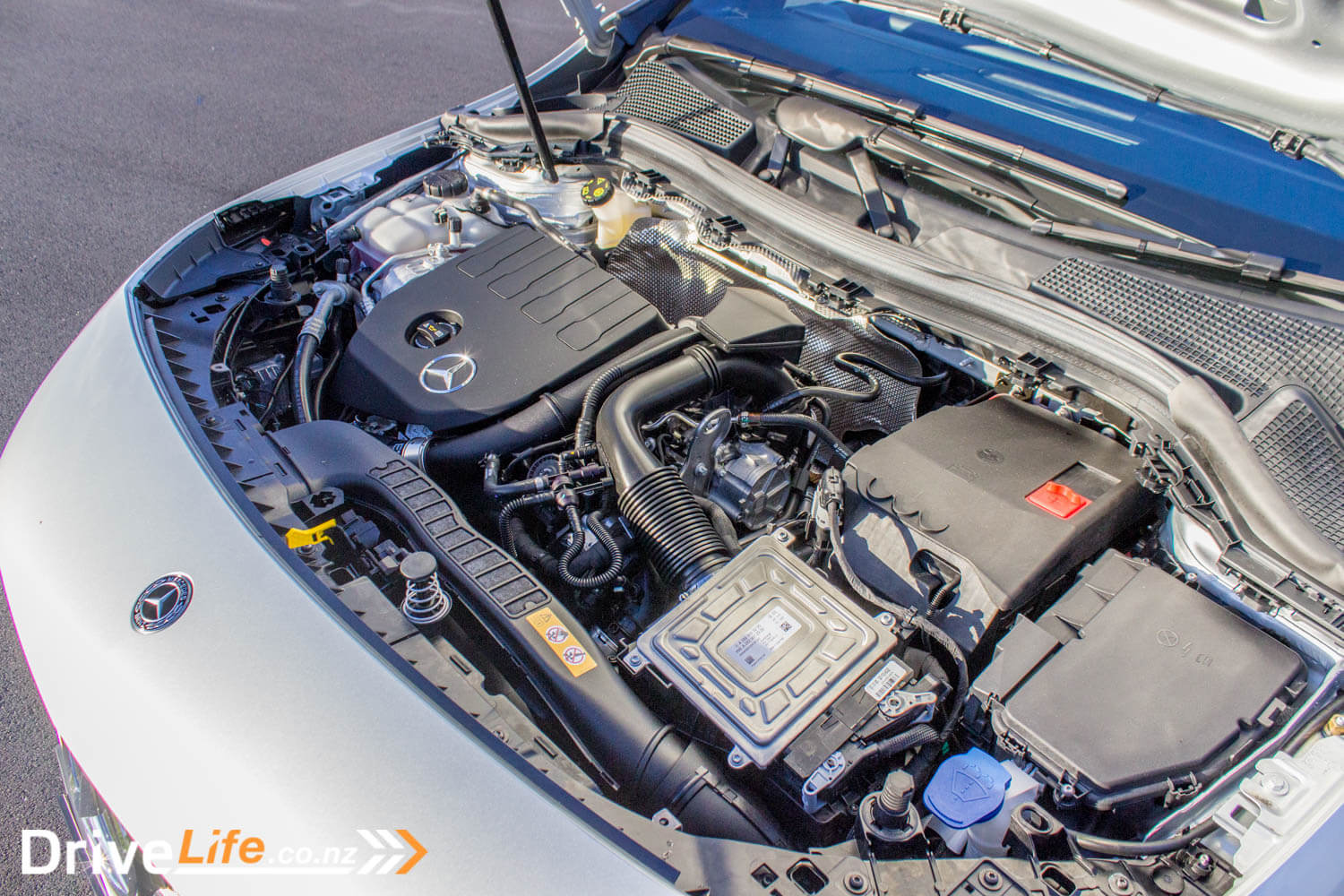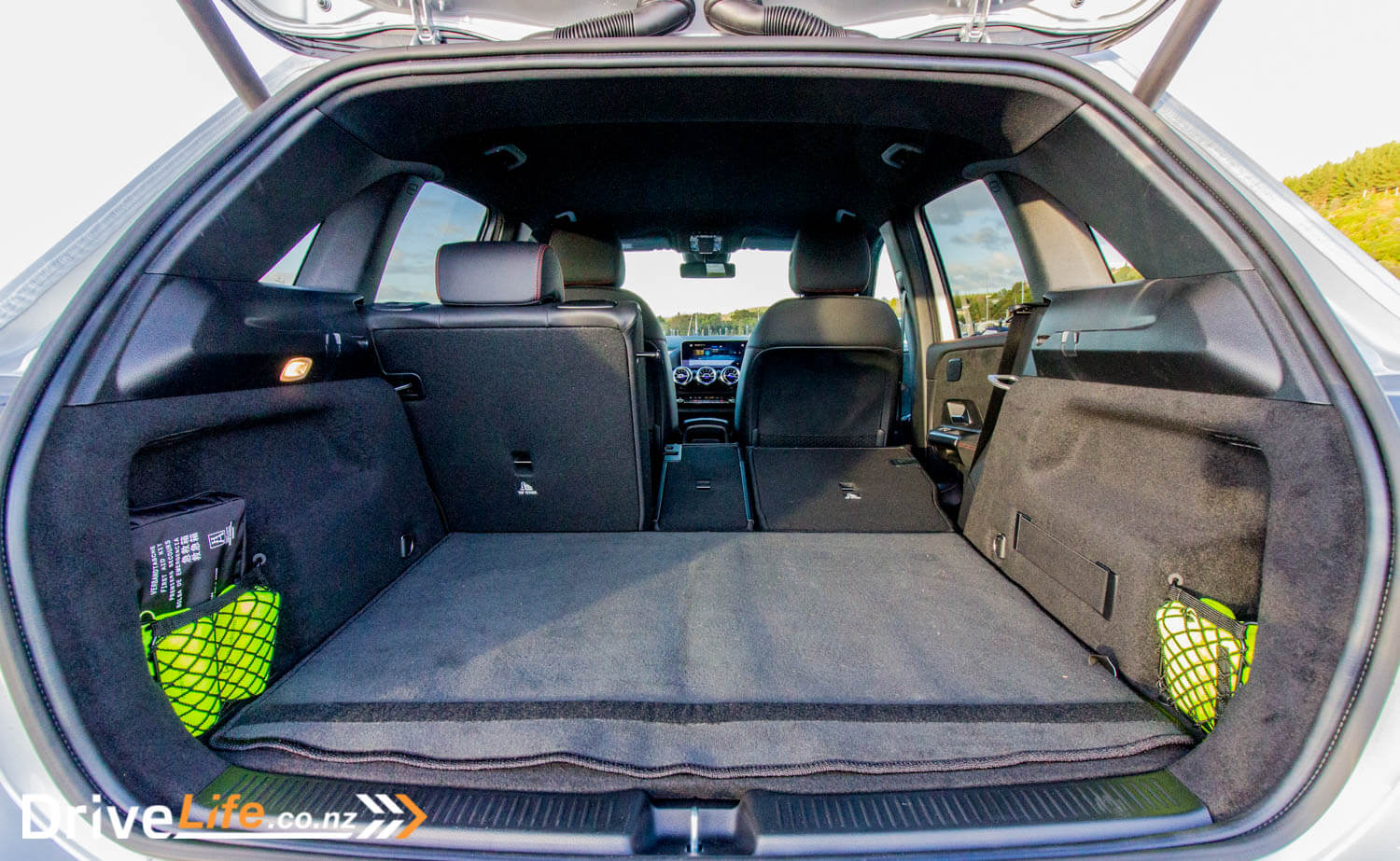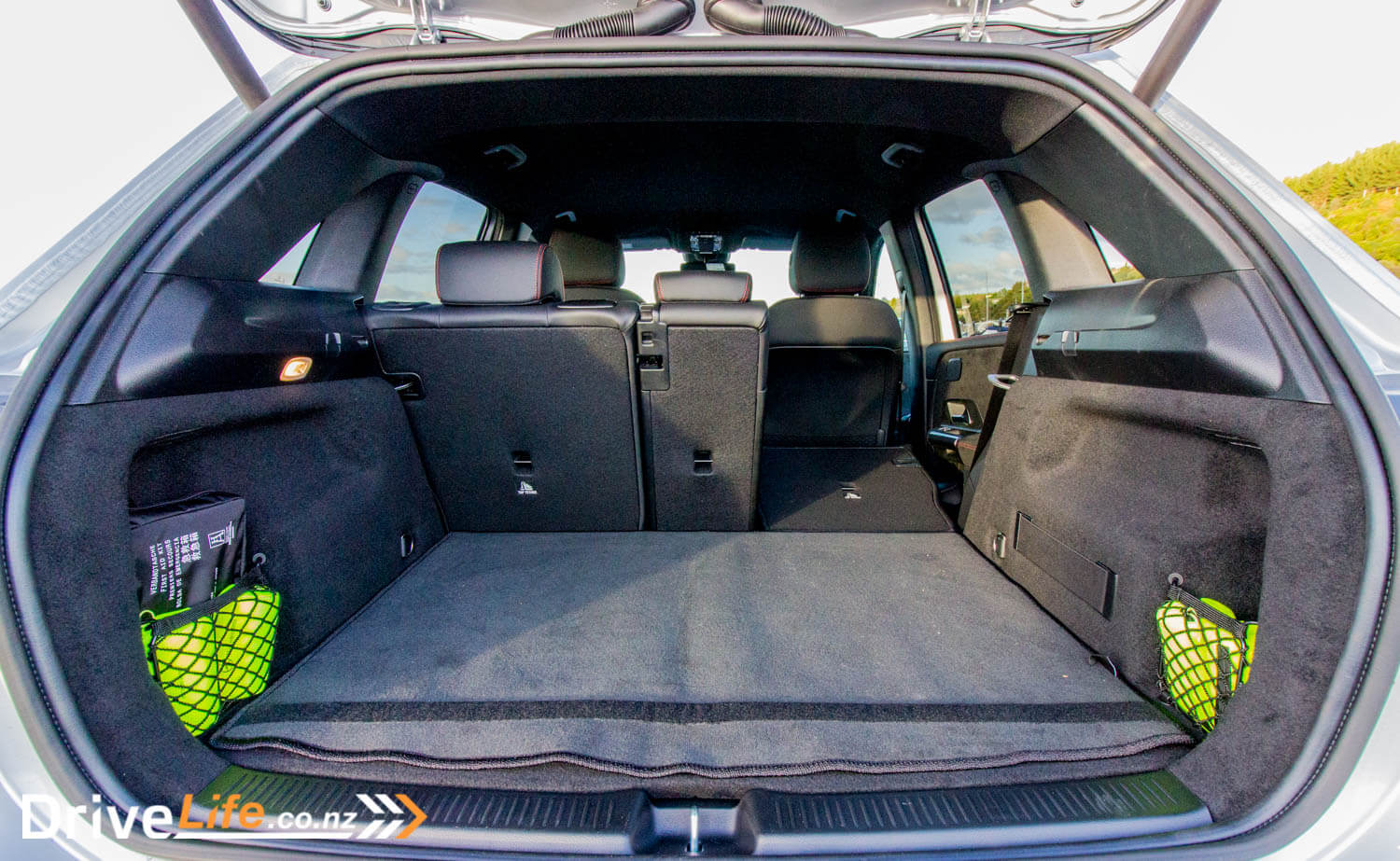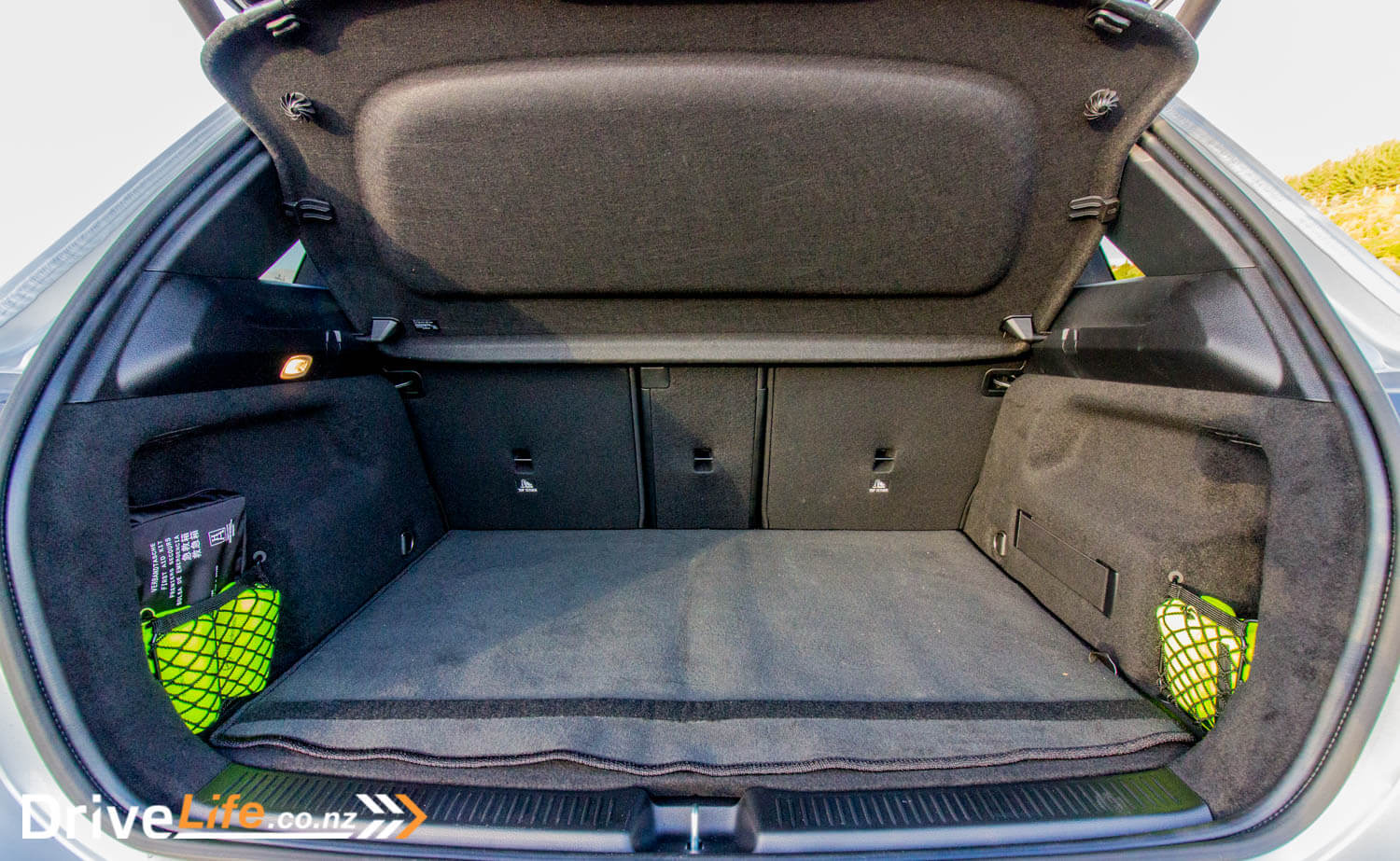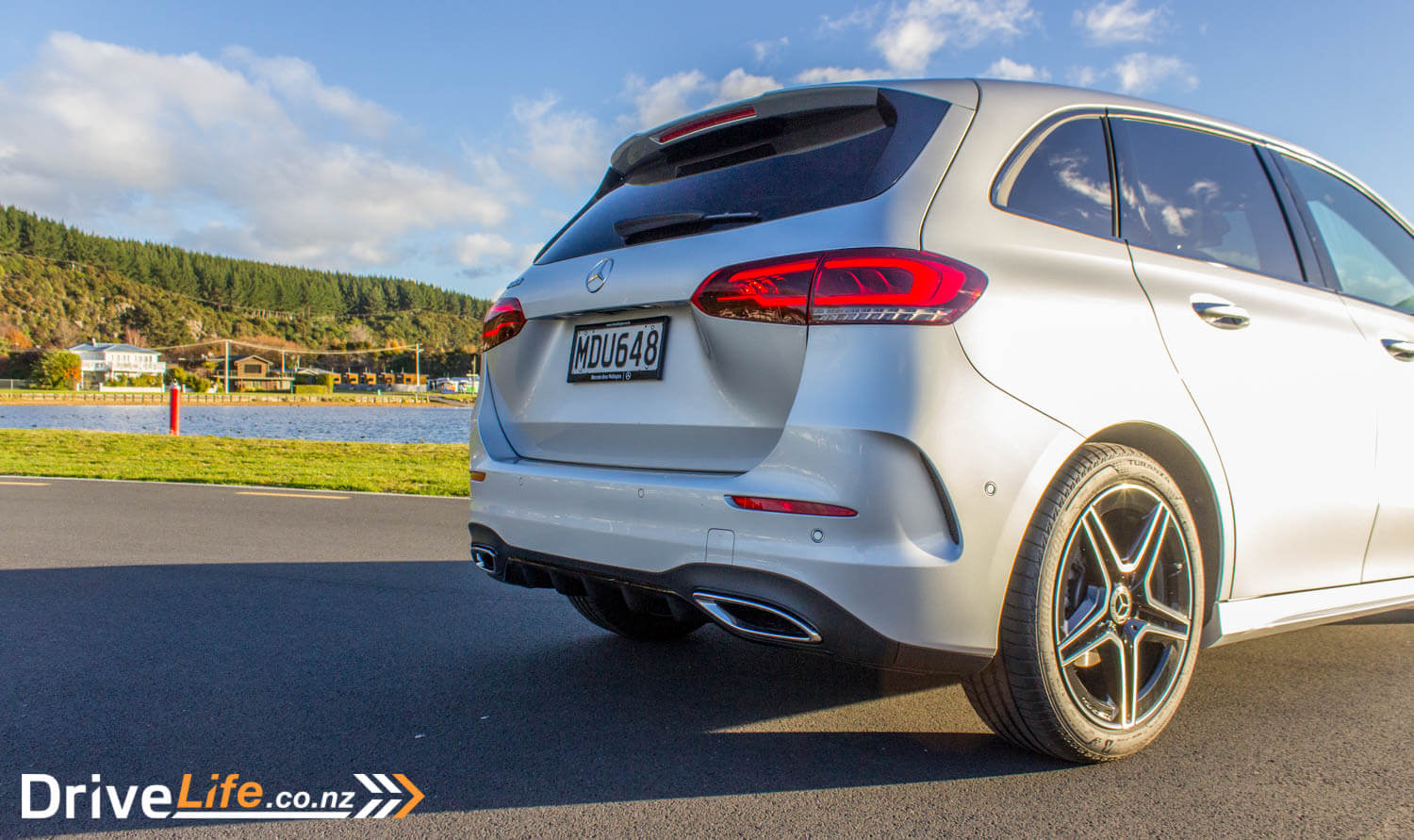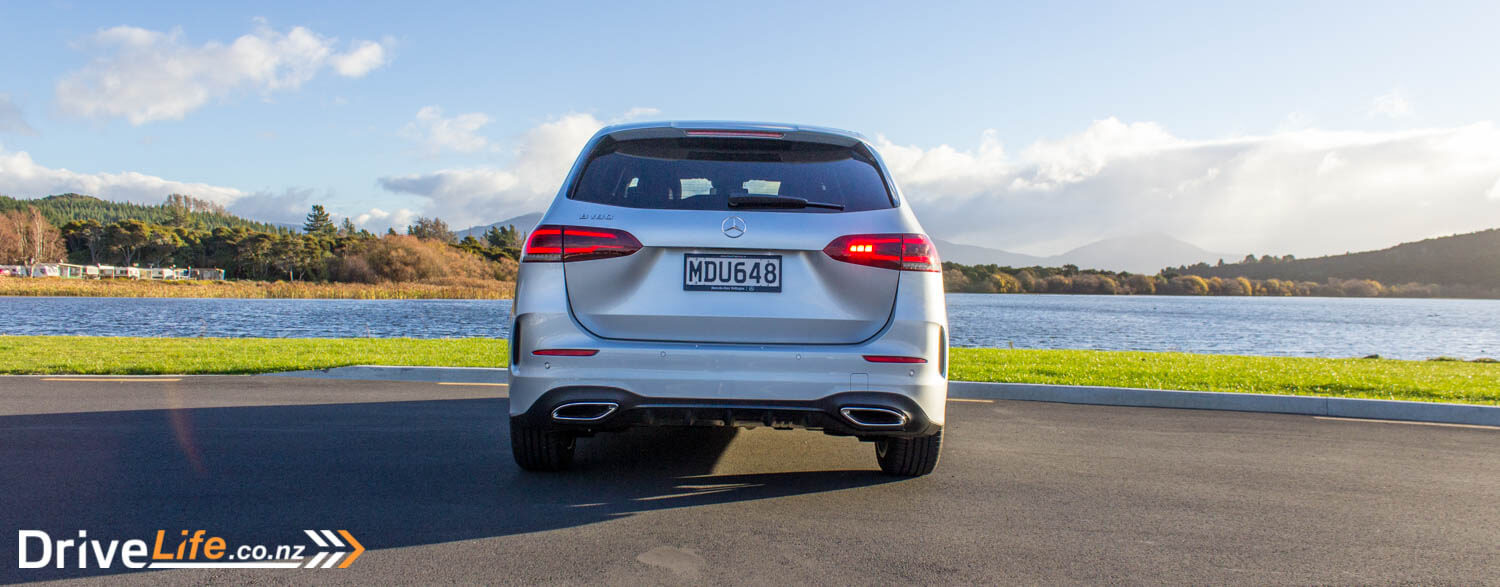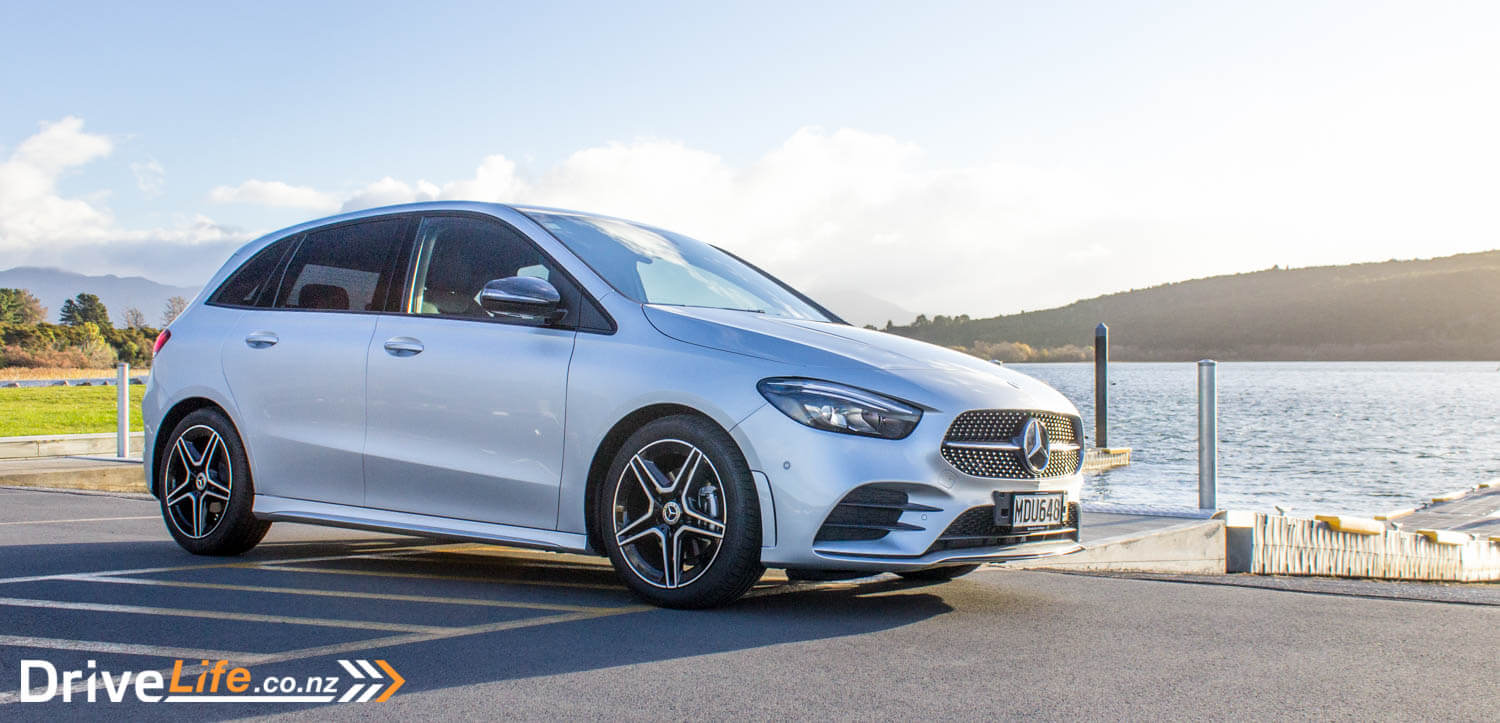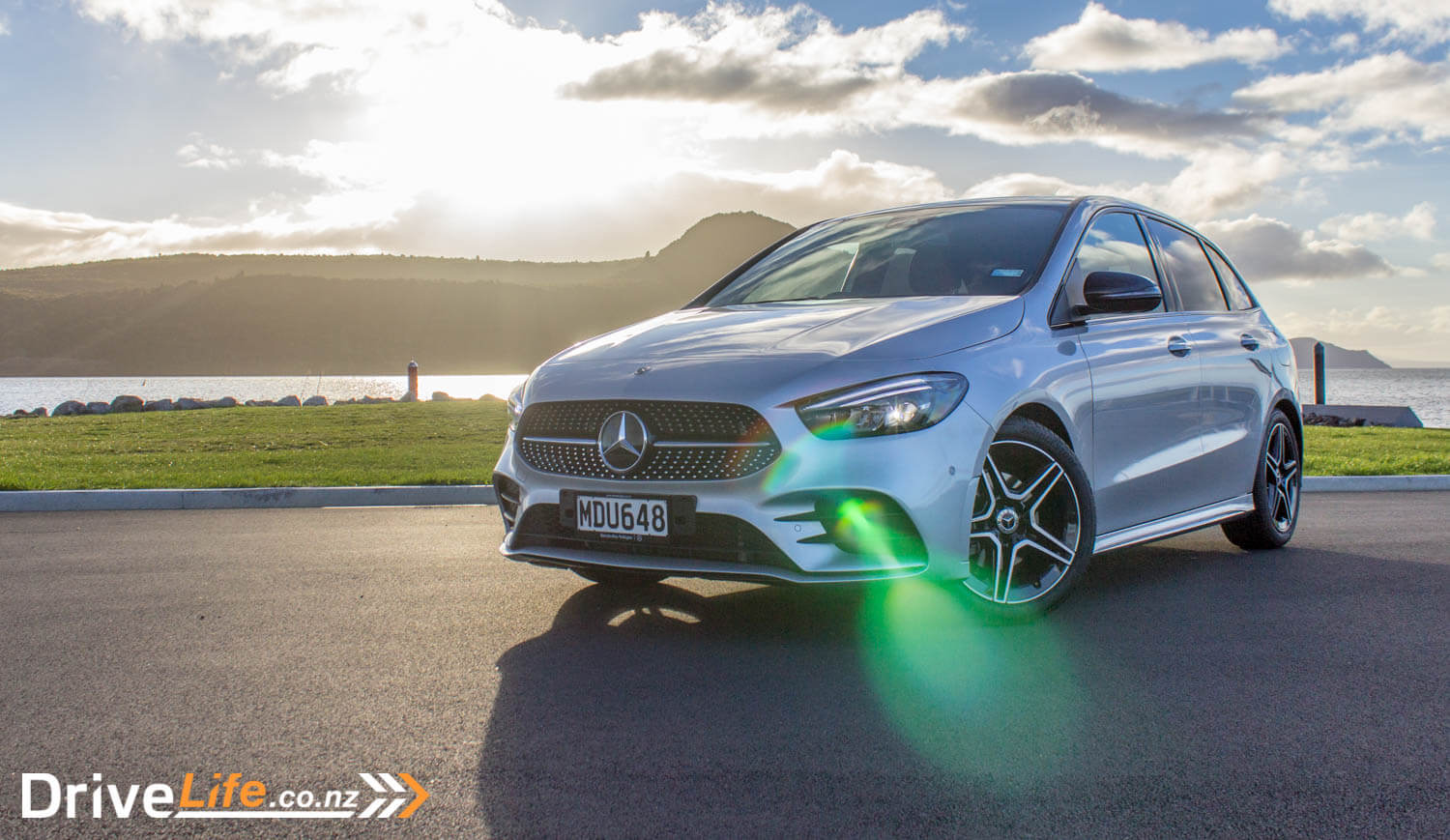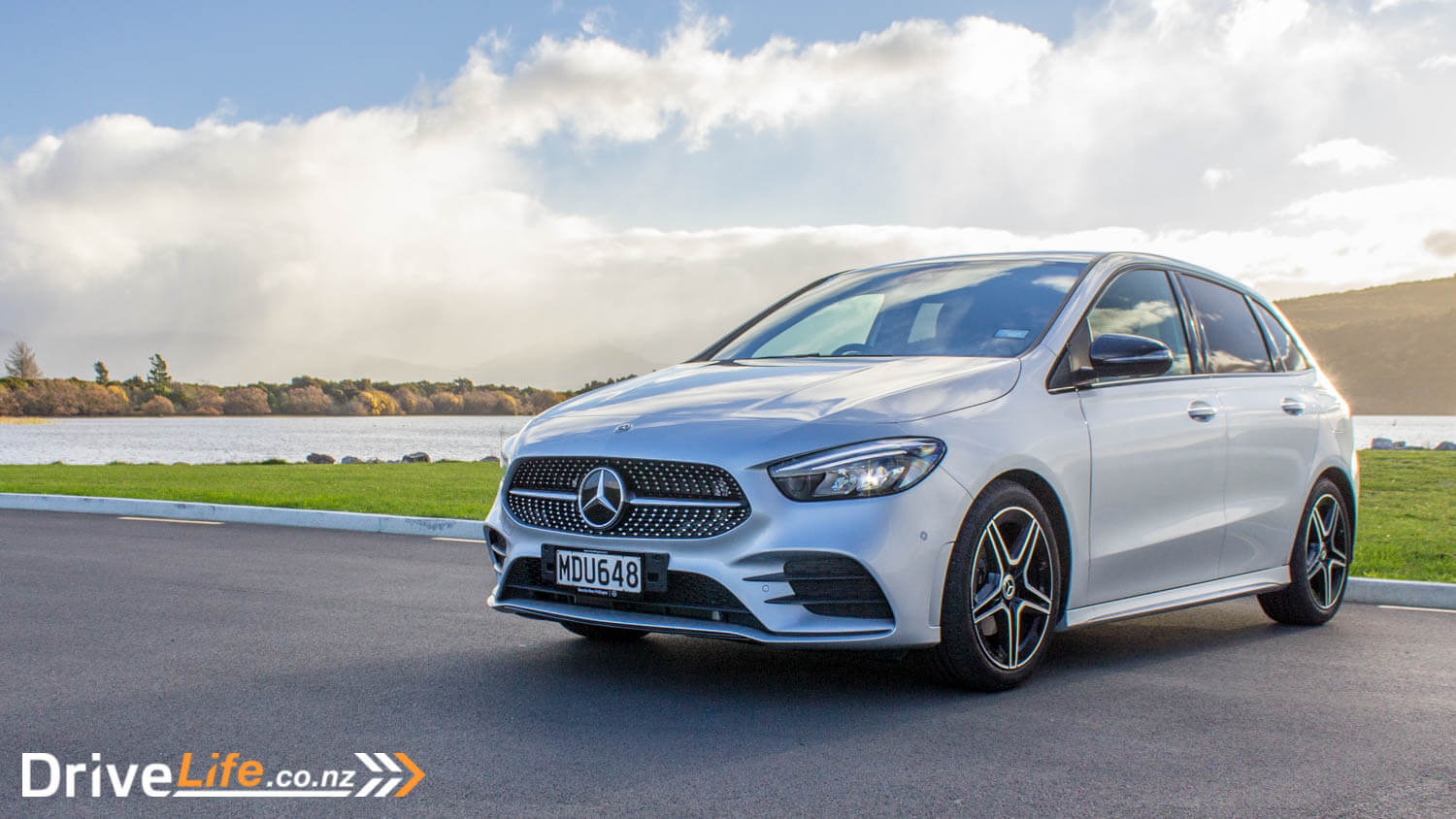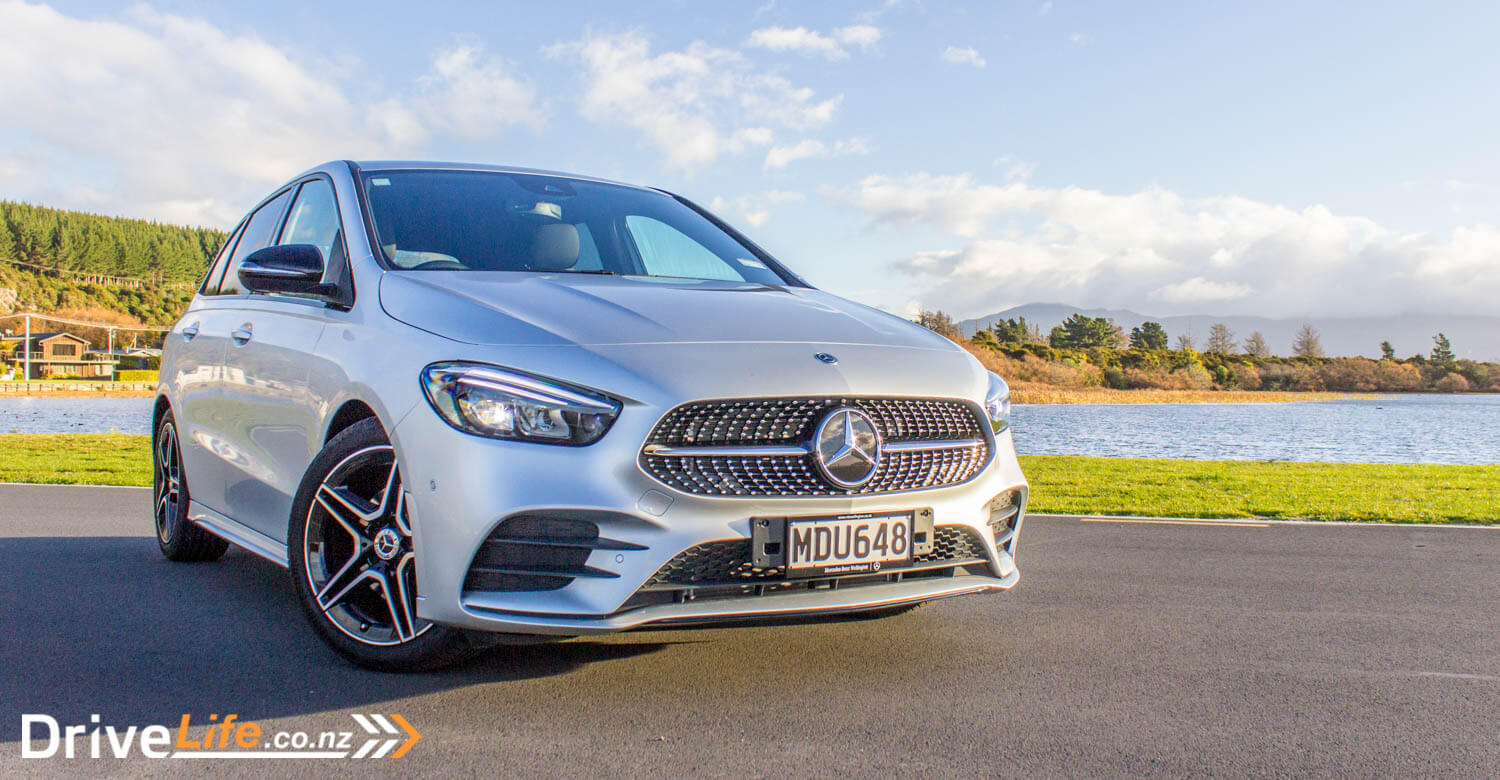Not long ago, we tested the completely refreshed A Class, and liked it – a lot. Now, Mercedes-Benz has given the B Class the once-over, with a slightly different look, along with an interior update. There’s more passenger and loading space too, as well as a taller seating position and increased visibility
While the A Class is a smaller car, it has grabbed the limelight with a string of awards. Can the B Class rise above its smaller sibling, and shine just as brightly?
Our test of the car included a weekend away to Turangi, so we were definitely going to be putting some miles on this car.
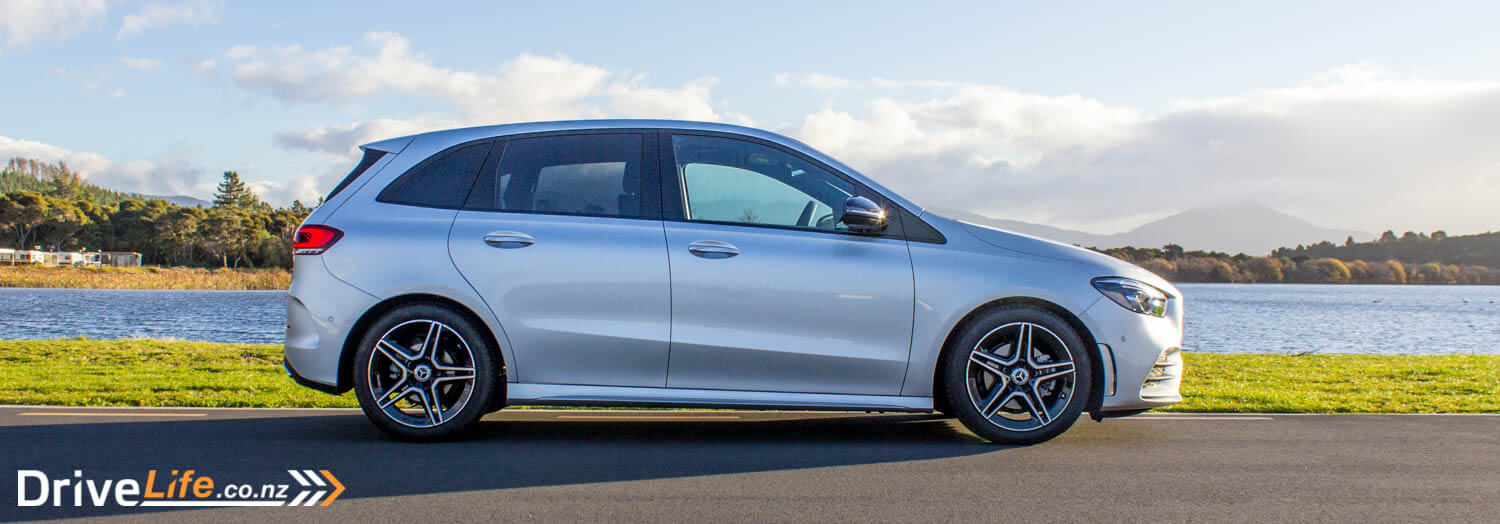
The Range
The B Class in New Zealand has been reduced down to just the one model – the B180. It comes with a 1.3-litre, 4-cylinder turbo petrol engine and is mated to a 7-speed DCT automatic transmission. The engine puts out 100kW of power, and a decent (for the car’s size) 200Nm of torque.
Standard equipment includes 17” 5-spoke alloy wheels, SatNav, 2×10.5” screens for a ‘widescreen cockpit’, DAB Digital Radio reception, Active Brake Assist, Active Parking Assist including PARKTRONIC, Active Lane Keep Assist, blind spot detection, traffic sign assist, a 180-degree reversing camera with dynamic guidelines, LED headlamps, keyless entry and start, an electric tailgate, auto-dimming mirror, an electric park brake, illuminated door sills, all windows one touch operation, Apple CarPlay and Android Auto integration, paddle shifters, auto wipers, a 225-watt audio system, Mercedes Me Connect system, cruise control with speed limiter, electrically folding exterior mirrors, LED DRLs, LED rear lights, automatic headlamps, and tinted glass.
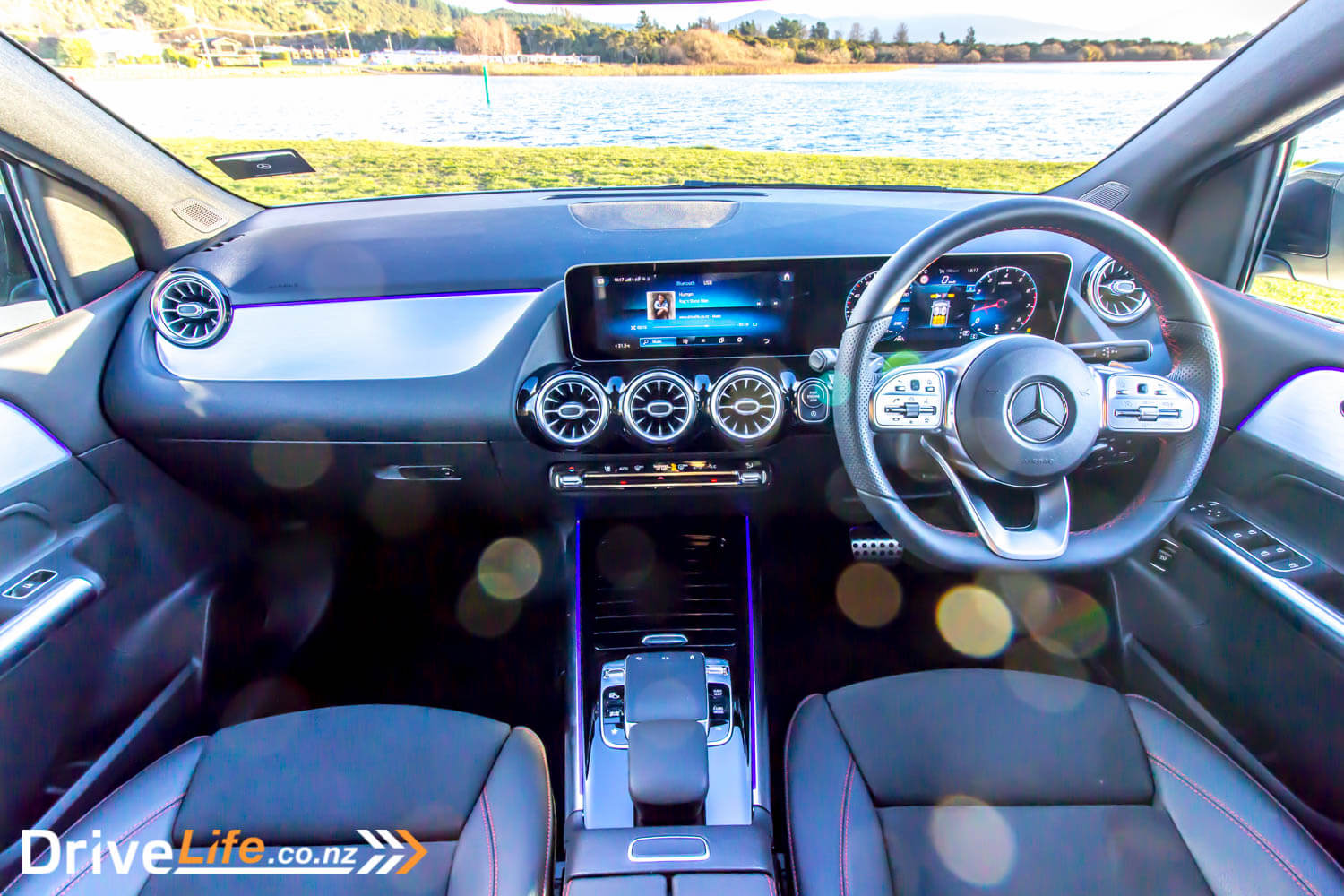
Our test car was fitted with a few options, like the Sport Package with AMG Line Exterior ($1,990), Seat Comfort Package ($1,290), Cosmos Black Metallic Paint ($1,190), Ambient Lighting ($490), for a recommended Retail Price (Excluding on road costs) of $62,760. Weirdly our car was silver, so I think there was a muck-up in the options list here. Qi wireless phone charging is a $350 option.
There’s just three standard colours; red, white, black. There’s five extra-cost colours available, three of them shades of grey/silver, Denim Blue, and Cosmos Black Metallic. These colours cost an additional $1,190.
You can read more about the B180 on Mercedes-Benz’s New Zealand website.
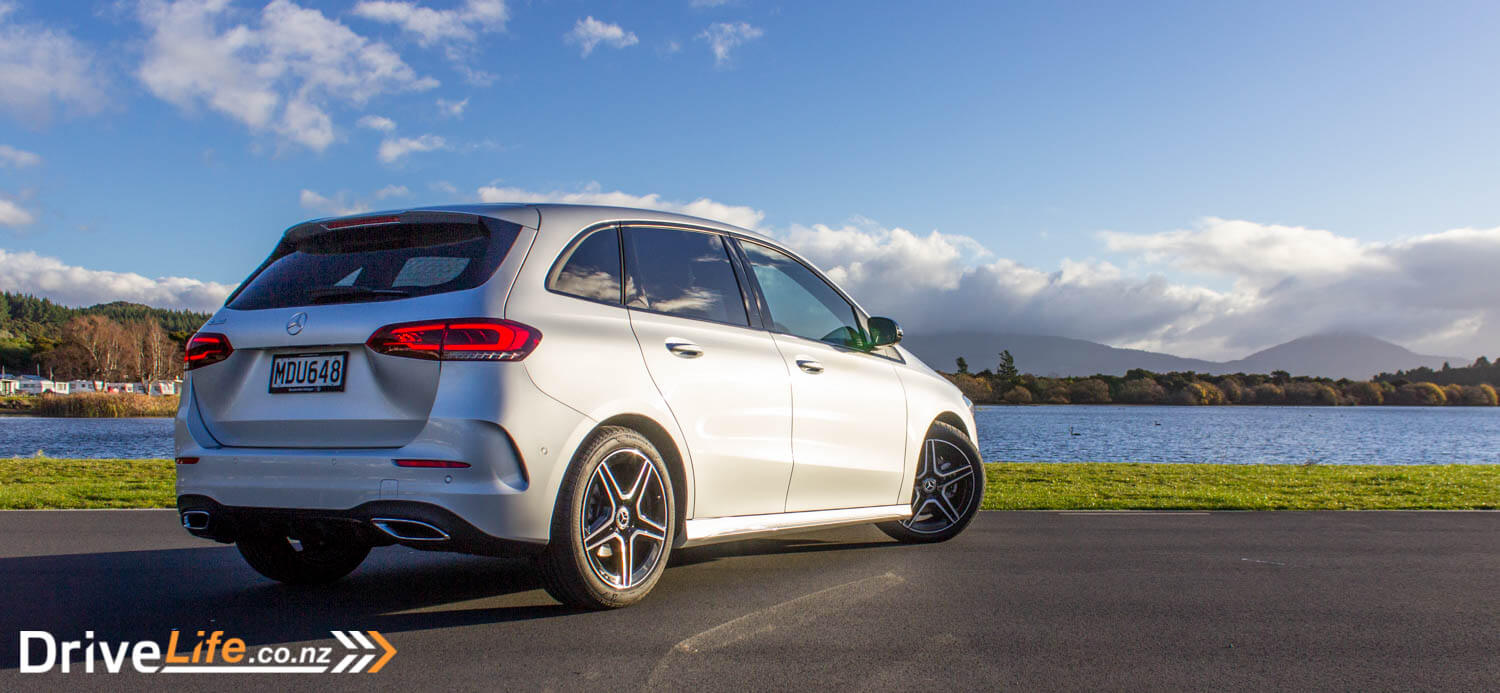
First Impressions
I have to be honest here, when I saw the photos of the new B Class, it didn’t do anything for me. Then I went to pick up our test car. Sure, it was finished in silver (Iridium Silver Metallic) – one of the colours that doesn’t do many cars justice – but it did look better in the flesh. I have love/not love moments with the B Class. My opinion changes as I walk around the car, or even stand and look from a lower angle.
The front can look sporty, fresh, aggressive. Mercedes-Benz calls it the ‘Predator’ nose. Then at other angles, it just looks…well, pick your own word. I think a colour change to a red, or even classic black would do it. Any comments from people who saw the car reflected mine. Some loved it, others not so much. Mercedes-Benz claims the B Class to be a Sports Tourer, which may or may not equal your view of what a sports tourer should be.
But you’ve got to hand it to MBNZ for not dumping the B Class and sticking yet another SUV out there. The B Class design is a dying breed, and I hope it’s here to stay.
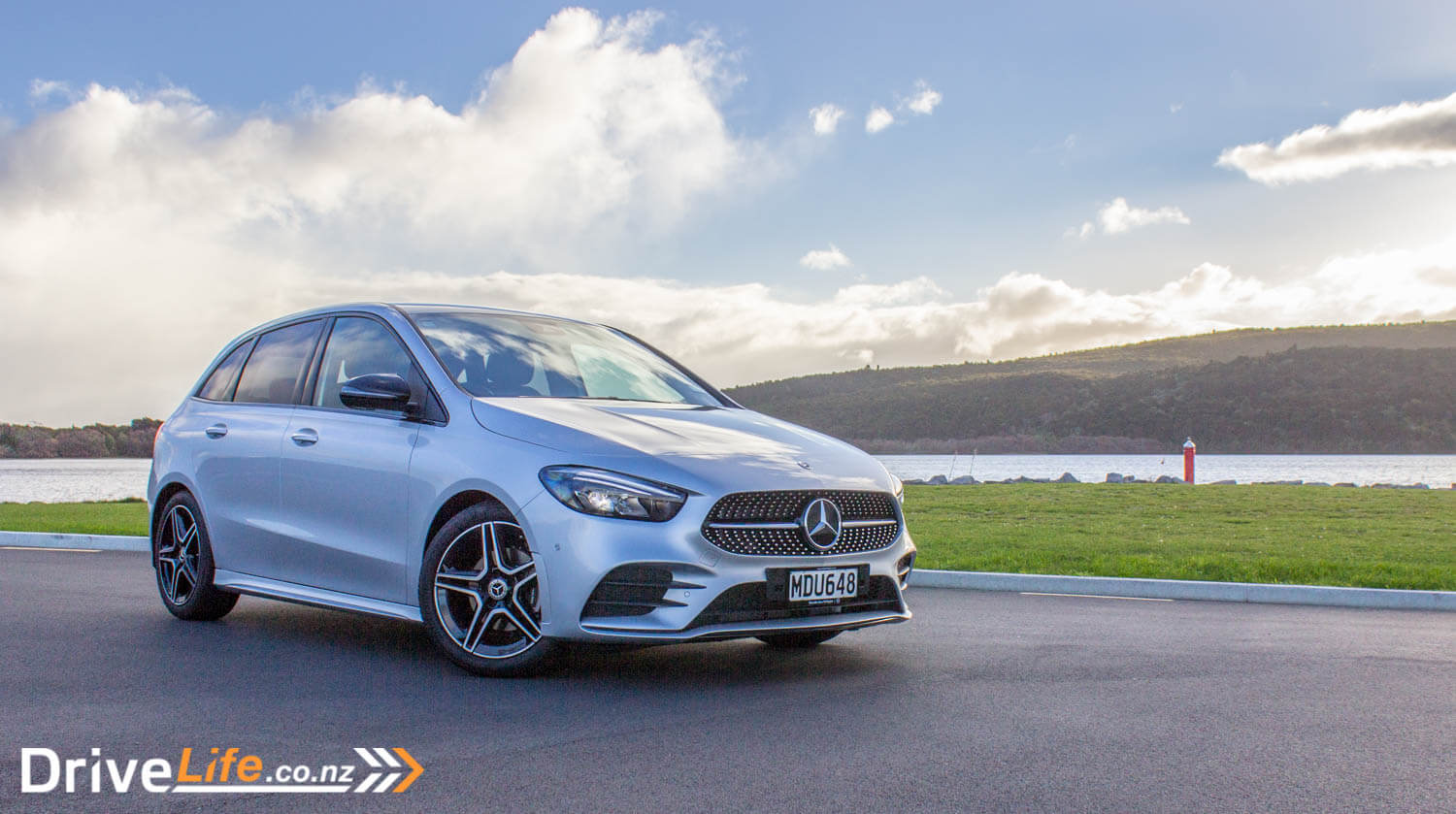
The Inside
One major upgrade for this year has been the adoption of two 12.3” high-definition screens across the front of the car, for what Mercedes-Benz calls a ‘widescreen cockpit’, the same as what we’ve seen in the C Class and E Class, as well as the A Class. These are a single pane, and look amazing. No one doesn’t comment on these; The definition is superb, and the operation of them equally so. Mercedes-Benz has it all over BMW in this department.
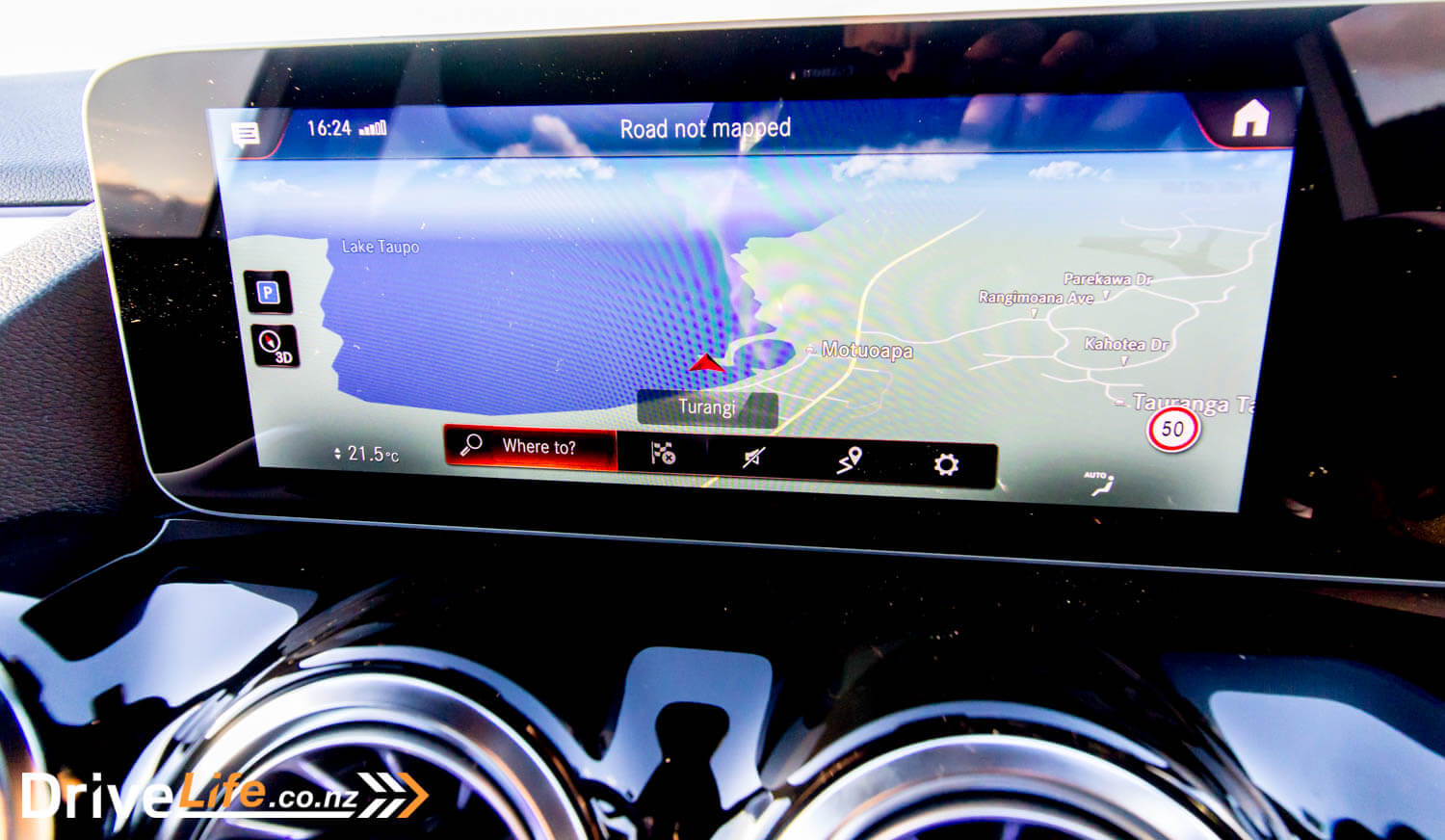
Our test car had black leather with red stitching on the doors, steering wheel and seats, and looked very nice, and classy with it. The steering wheel catches people’s eyes too – it’s pretty small, and yet still has all the same buttons on it that a C Class has. Flat bottomed too, with some paddles tucked around the back. I guess this is the ‘sports’ part of Sports Tourer.
There’s piano black finish on the centre console and dash, and it really suits the car. On the doors is grey padded suede right where your elbow goes, and it feels fantastic. All the touch points from the driver’s seat are a quality material of some sort. Even the stainless steel trim running down the sides of the centre console feels great.
More black finish in the headlining, unfortunately. This does mean it’s quite dark inside the B180.
Rear legroom is surprisingly good; far more than the Lexus UX I had just handed back. Another bonus is that the rear seats are quite high, and with those huge rear door windows and low beltline, it should make travelling with kids much easier. Hopefully all that light and height will keep car sickness at bay. With the front passengers sitting so tall, this has also meant that there’s gallons of space under the front seats for feet, or jackets etc. There really is a lot of space under there.
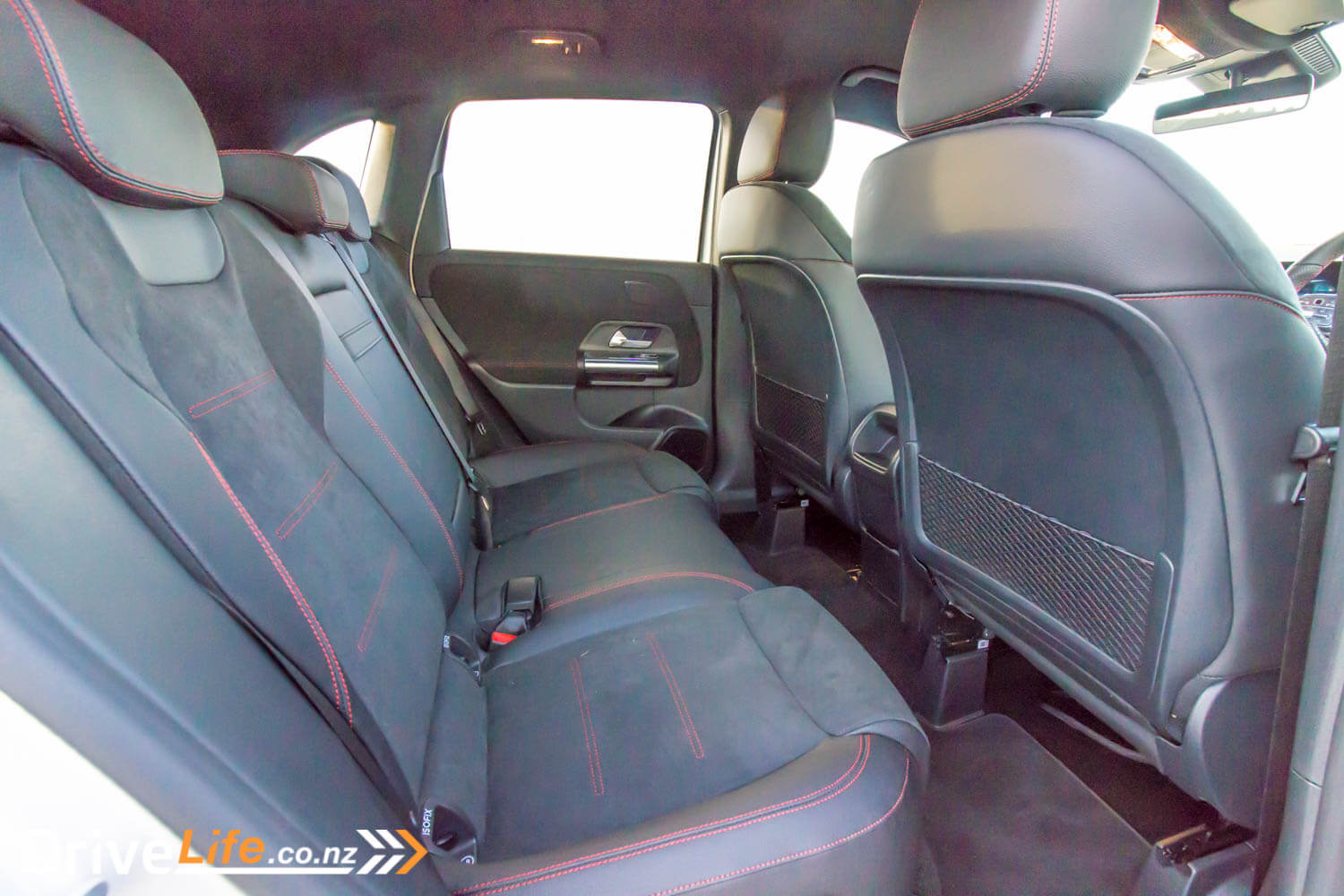
Headroom is excellent too, as is entry/exiting the car. Everything about daily use of the B Class is simple, and logical. The cabin is 33mm wider than the previous model, too. One of the strengths of the B180 is its interior space and utilisation.
The centre console switches have gone for the typical Mercedes-Benz minimalist look, with buttons controlling the AC only. The heated seat buttons are on the doors, as are the power seat buttons.
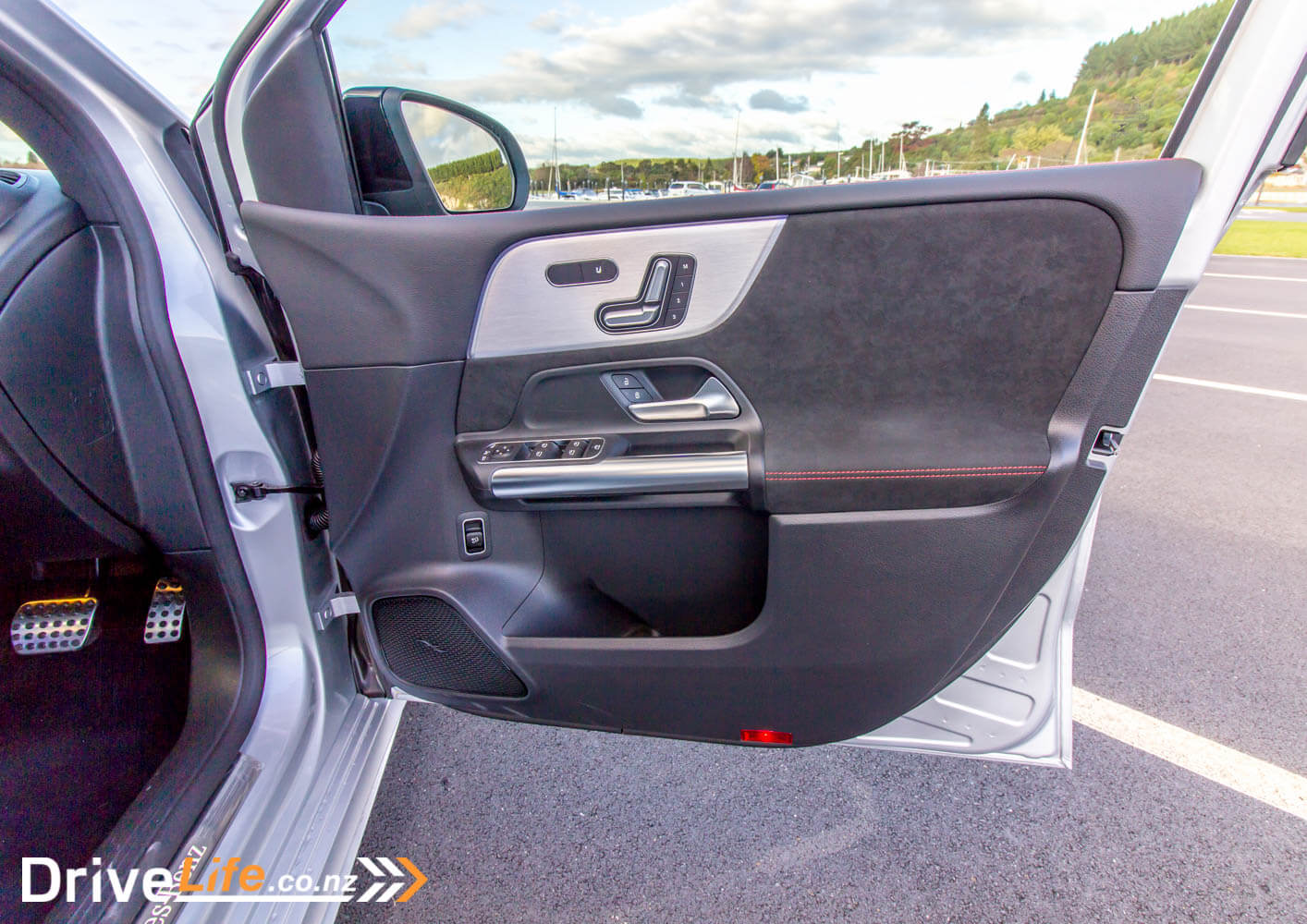
Across the dash are 5 sexy turbine vents that we first saw in the C Class, but are now fitted to most models of Mercedes-Benz. They look so good, and in the B Class are illuminated as well, with a huge selection of colours to choose from just for the vents.
The boot is a very reasonable 450 litres with the seats up, and an excellent 1450 with them down. We had no issues in fitting in all that stuff you take away for a weekend, and don’t end up using.
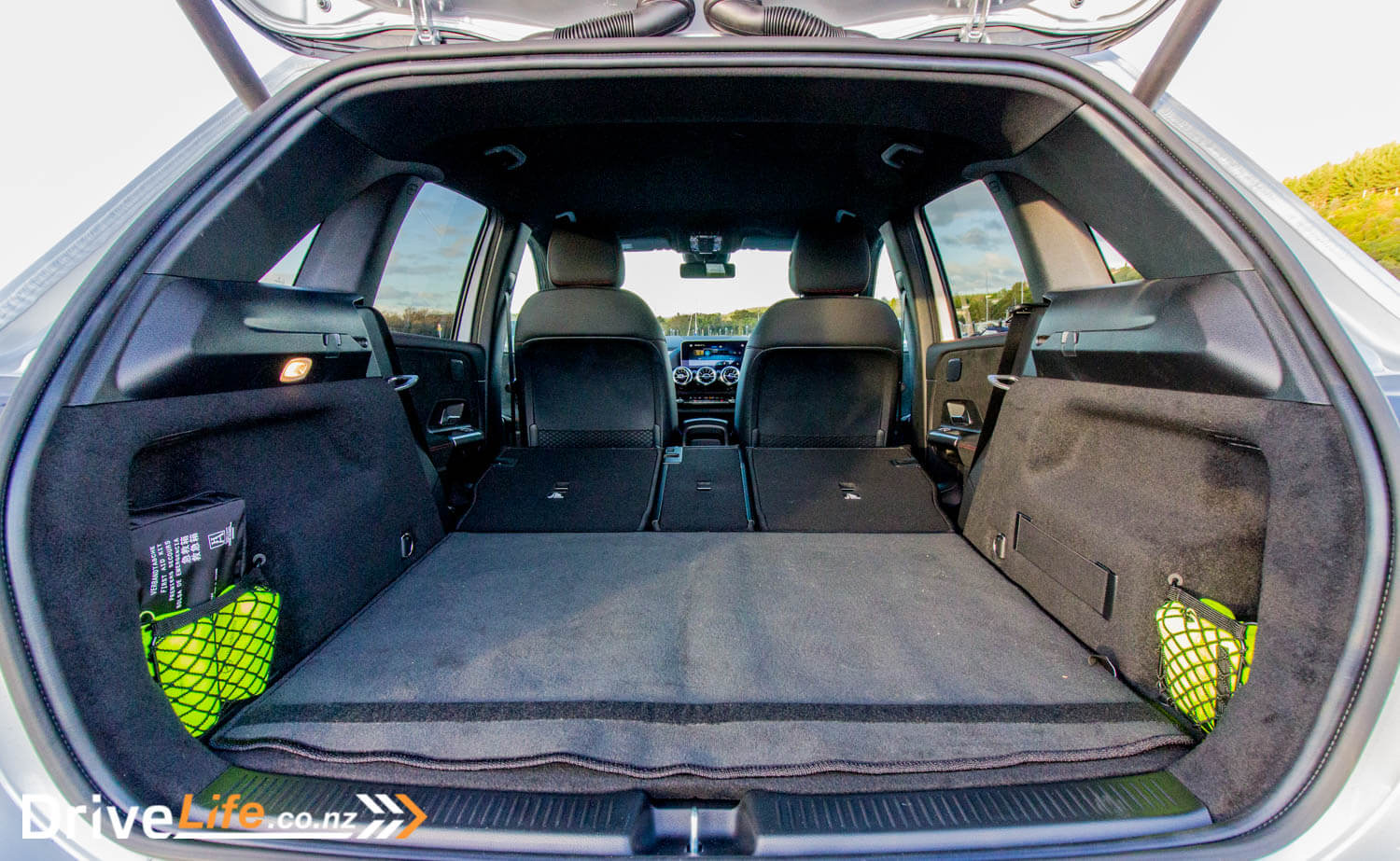
The Drive
I’d just handed back a Lexus UX, and its touchpad which I didn’t like using at all. The B180 also has a touchpad controller. The main screen is touch, so if you struggle with the touchpad, there is always that option too. The touchpad in the B180 was definitely better than the Lexus one – easier to use when on the move. There’s a leather-wrapped wrist rest just south of the touchpad, and it’s perfectly placed to do its job.
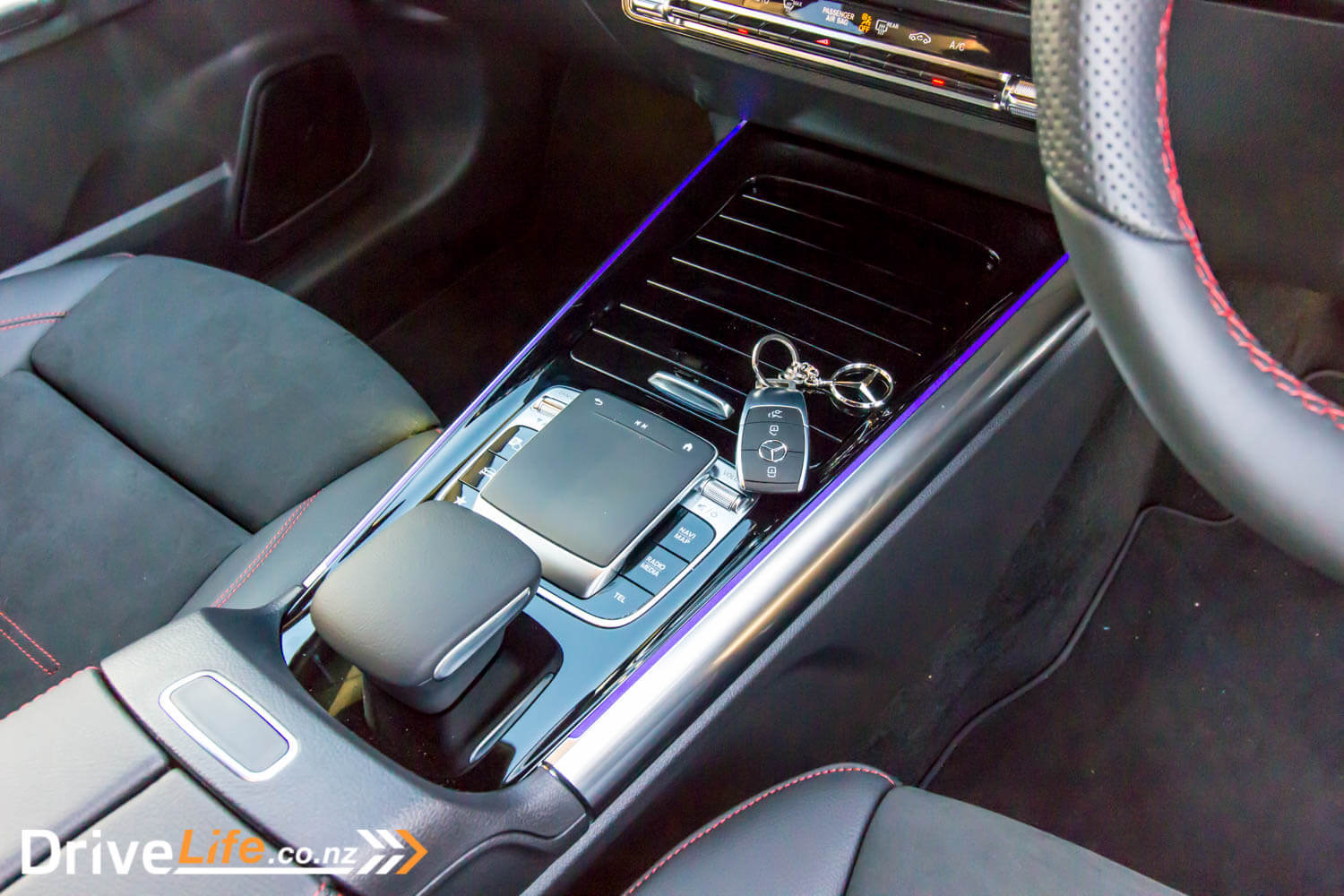
First up though, connect my phone. Simple and quick, over my week with the car the Bluetooth reconnected every time almost instantly. You’d be surprised how many cars still struggle with this.
That steering that looks small feels small too. But the buttons work excellently; they do feel more cramped than on the C Class, but after less than a day with the car, I barely looked down at them again – it was all by touch. One drawback with the steering wheel controls is that there’s no button to skip a track or a radio station – you have to do this via the touchpad, or select Media on the main screen and then do it there. Not the end of the world.
I hugely appreciate that MB have stuck with the volume thumbwheel on the steering wheel to adjust the volume – and are one of the few manufacturers to do this. Most use a separate button for volume up/down, but MB does it simply and more effectively with a scrolling knob. Want to mute the audio? Press the thumbwheel in – no need for a separate button. This is the best.
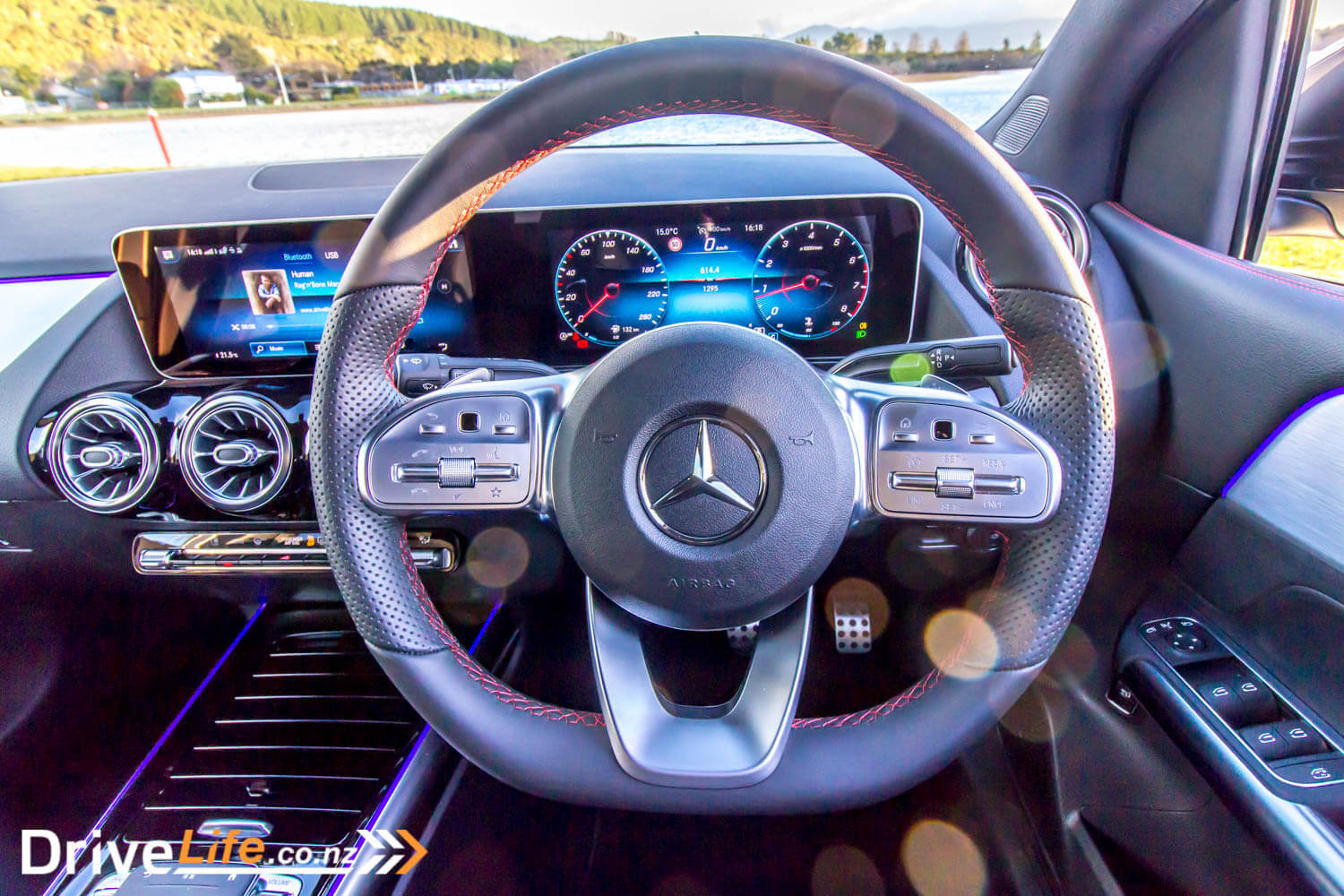
The B180 includes Android Auto and Apple CarPlay capability, but keep in mind you must connect to front USB port, not the one in the centre cubby. Both USB ports are the new C type, but you do get one adaptor with the car.
Mercedes-Benz have mentioned more than once in the press material about the changes to the cabin in the B180, and you can really feel those changes. Aside from the black headlining, it’s an airy place, and there’s heaps of room. It’s no tardis, but it’s a very usable urban vehicle.
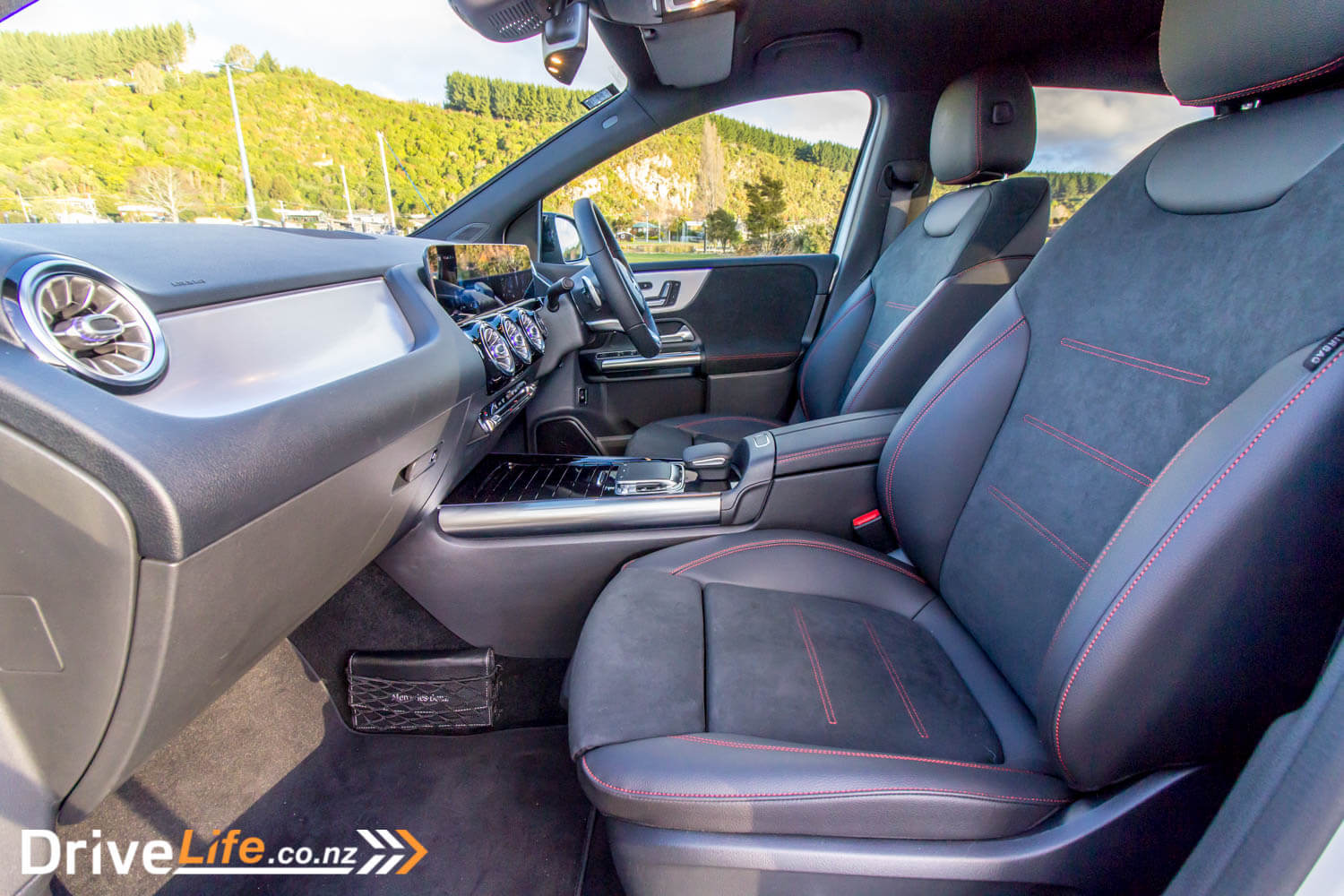
Driving it reminds me of an MPV; you sit very upright, like a bus driver – this is a car you sit on, rather than in. This does mean great visibility, and this is one of the B180’s core strengths. With huge side windows and Blind Spot Monitoring, the B Class is a doddle to drive around town, or on the motorway. There are some fairly chunky A pillars to restrict your forward vision a bit, but this is common now, for safety reasons.
Does this mean I am saying the B180 is the perfect urban vehicle? Unfortunately, no. A couple of reasons for this, and the main one is the dual-clutch transmission. We’re used to some jerkiness in a DCT – it comes with the technology that is DCT. But the B180 suffers from this the most I’ve seen yet. A clean start from the lights is tricky, as you press the gas pedal, and then wait…then the transmission decides it will move forward after all. When the B180 is cold, it’s worse again. When you select (say) reverse after starting the car, it can take a second or so for the transmission to actually go into reverse. Of course during this time, you’ve given it a bit of gas, and it doesn’t move. So you give it more gas and then it all happens, and you start rocketing backwards.
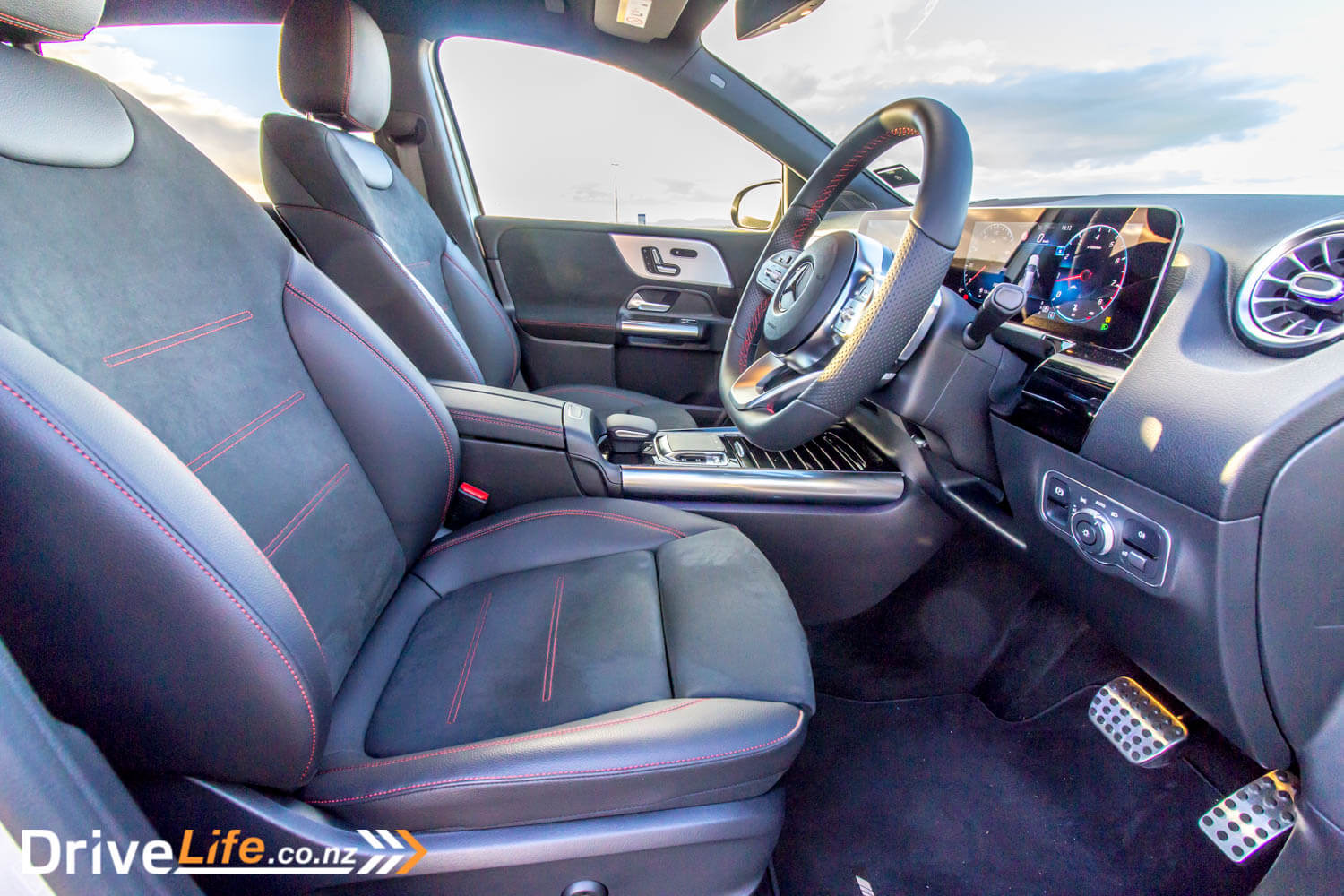
For those who don’t know, a dual-clutch transmission does away with the torque converter, instead using (you guessed it) a dual-clutch system to change gears. It’s not a manual gearbox, but it does have some components of a manual ‘box. We can nearly always tell when a car has a DCT – they are a little jerkier away from a start. But unfortunately, the B180 suffers from this more than others I’ve driven. It’s funny though, as this gearbox is the same as the one fitted to the A Class – and yet that wasn’t as bad. Go figure.
The second reason I didn’t like the B180 is the Lane Keep Assist (LKA). It’s an active system, which is fine, but it’s far too aggressive, and if your B Class touches either white line the car starts to put the brakes on. Not gently, either – they come on with a rush, and I’ve got to say it really wakes you up, and will freak your passengers out. I checked the options for LKA and it was set to ‘Normal’. I tried ‘Sensitive’ but of course this simply made it worse. Not a big deal – I turned LKA off. But then when you get out of the car, and then back in again, it turns itself back on. You might not notice this until your tyre touches a white line, then you have that scary moment all over again. This area of the B180 needs work, even if it was only something like being able to change the settings so that there was an audible warning instead of an active system.
Other than those two things, the B Class is a joy to drive, and on a Friday afternoon we loaded it up for a trip to Turangi. Mercedes-Benz advised me this is a car designed for the urban environment, and to keep that in mind. They needn’t have worried, as the B180 is a worthy open-road car. That 1.3-litre, turbocharged four-cylinder petrol engine is very willing to rev out, and it’s really on the open road where this car excels, as you leave the memories of jerky starts behind.
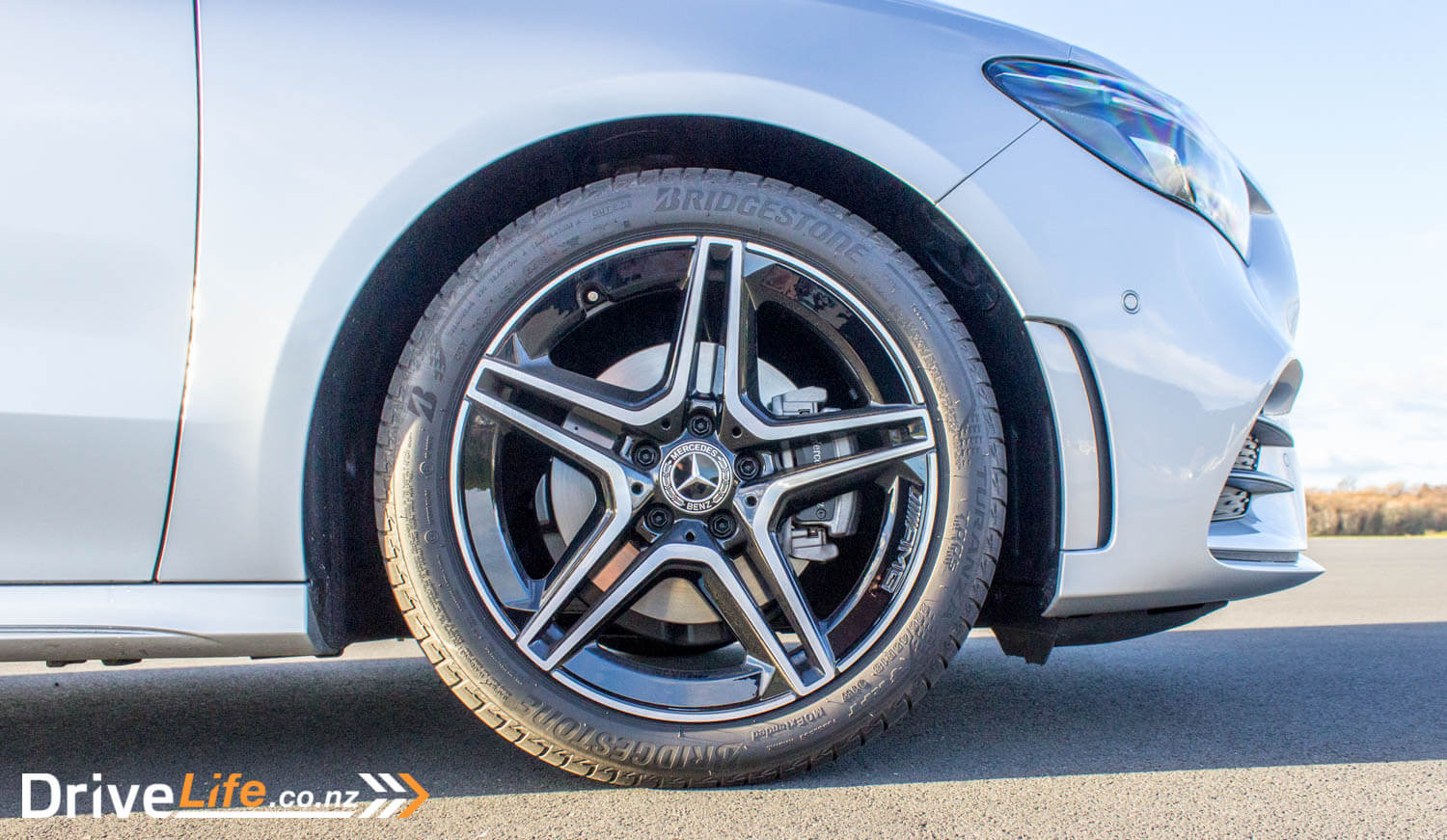
In fact, along with visibility out of the car, the engine is another high point of the B180. It’s a gem; smooth and quiet, although it does sound nice when you take it out over 4500rpm. It’s not super powerful at 100kW, but it’s more than enough to get the car moving as quickly as you need.
It’s not a perfect open-road though; there’s a little too much tyre noise coming through the car, and it’s worse on coarse-chip seal (what car isn’t, though). But still, it does very well loaded up and cruising the roads out of town. I did miss having adaptive cruise control – I really thought it’d be standard – but at least the cruise control it has is a one-touch operation. It brakes the car downhill too, so that’s always a bonus. Nothing worse than standard cruise control that gets away on you down a hill, and you don’t notice (flashing red and blue lights, anyone?).
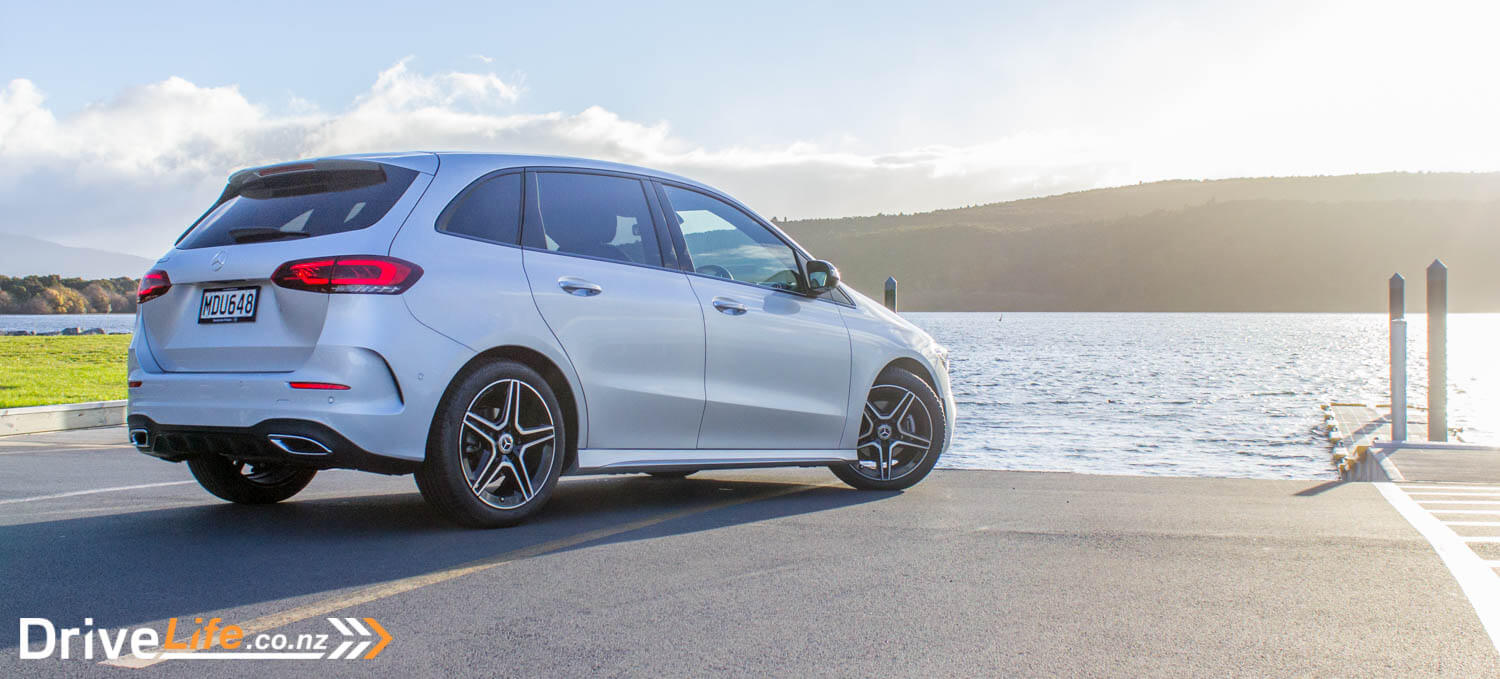
Saturday morning, and a meeting in Taupo meant I got to ‘test’ out the B Class by myself, with no threat of car sickness from a certain passenger. This is where the B Class will surprise you; it’s actually a blast to drive on the twisty bits, if you have Sport mode on. Steering feel is surprisingly good, body roll is there but well controlled, and the car revels in a slow in/fast out approach. I had to remind myself it’s front-wheel drive, and not all wheel drive, as it fair sailed around those 25km/h bends south of the lake in the early hours. The B Class is a very chuckable car, even with the high seating position.
After my meeting, I gassed the B180 up, after 700km total distance. Fuel economy overall was pretty good at 5.9L/100km, with an overall mileage of 1,100km. Mercedes-Benz says 5.7L/100km, so I was almost on the button. This is surprising, as we’ve had a few cars in the last 12 months with small capacity turbo motors, and while they go extremely well, they do like a drink or two.
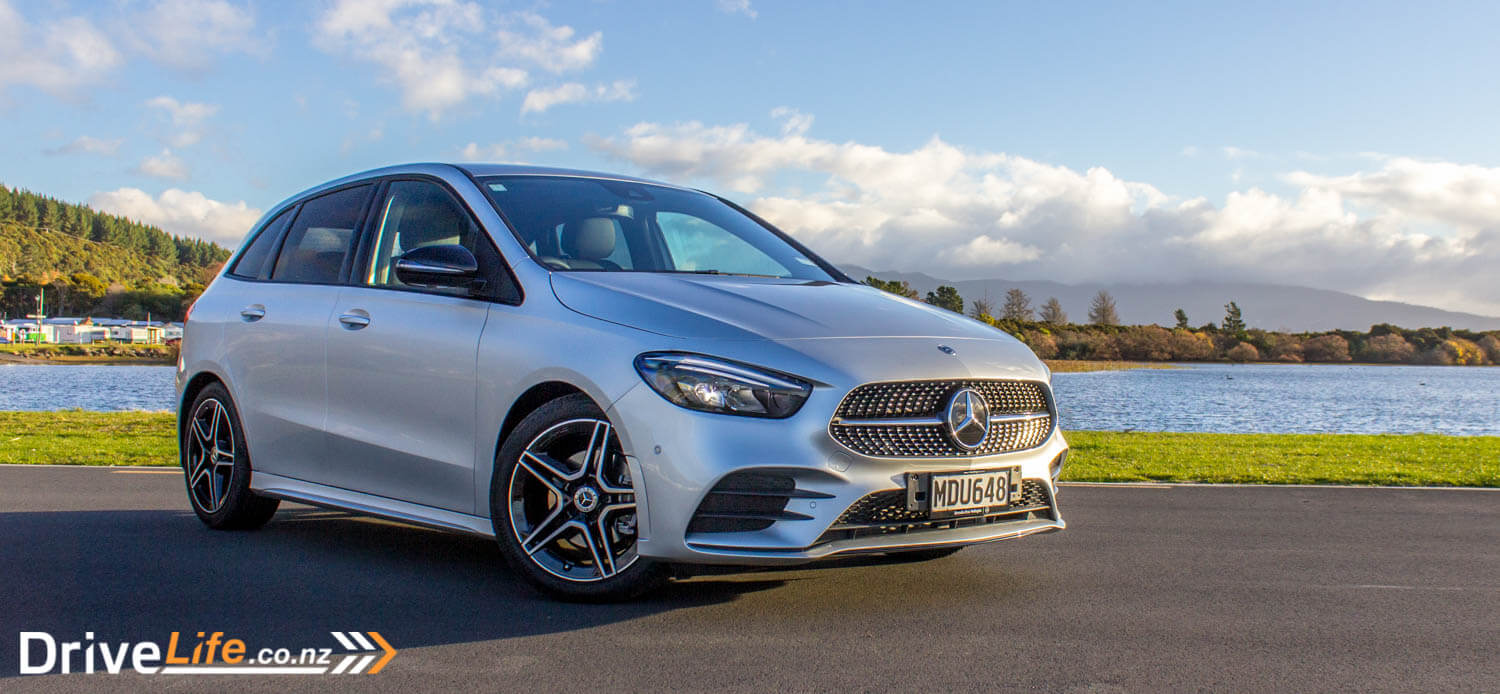
On the return trip from Turangi, we decided to test out the Seat Kinetics; these are supposed to relax you and help your body, as the seat moves around to get your body to change position, while you drive (for the driver and/or passenger). You can select from either only the backrest, only the seat base or both together. You can also set the duration, selecting from short/medium/long. Did it work? Yes and no. The seat base moved as did the back rest, but it’s a tough call. I think it made a difference, and likely over a longer drive it would make more of a difference.
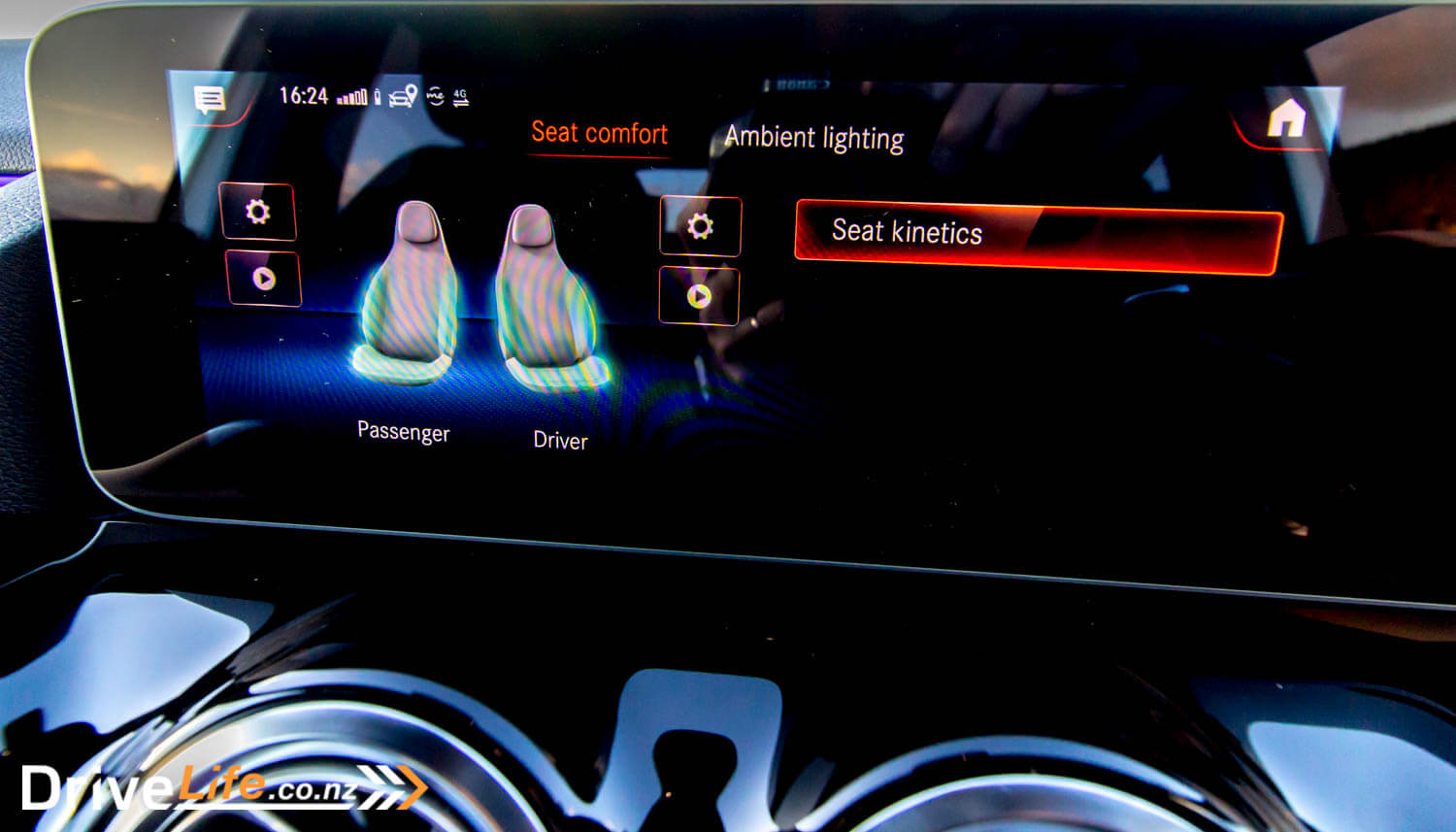
Along with the A Class, the B180 now includes the MBUX (Mercedes-Benz User Experience) system. To kick it off, you say ‘Hey Mercedes’, and she responds to your every request. Well, almost every request. It’s easy enough to change stations, or change the car’s temperature using voice comments, along with other car functions. There’s a slew of commands (33 of them) she’ll respond to, meaning more time with your hands on the wheel rather than looking for buttons or scrolling through menus.
Included in MBUX is a smartphone app that allows you to control certain functions of the car. This includes things like remote door locking and unlocking via the app; being able to identify and navigate the vehicle to nearby parking spaces; remotely pre-programming a destination into navigation ahead of a journey; geofencing, which allows the owner to set a boundary for the vehicle and to be informed if the vehicle leaves the area; and optionally an alert if a collision has been detected, the anti-theft warning system is triggered, or the vehicle has been towed. In future, the app will be able to be linked to in-home devices such as Amazon Alexa or Google Home, enabling control of key vehicle functions via home-based spoken commands.
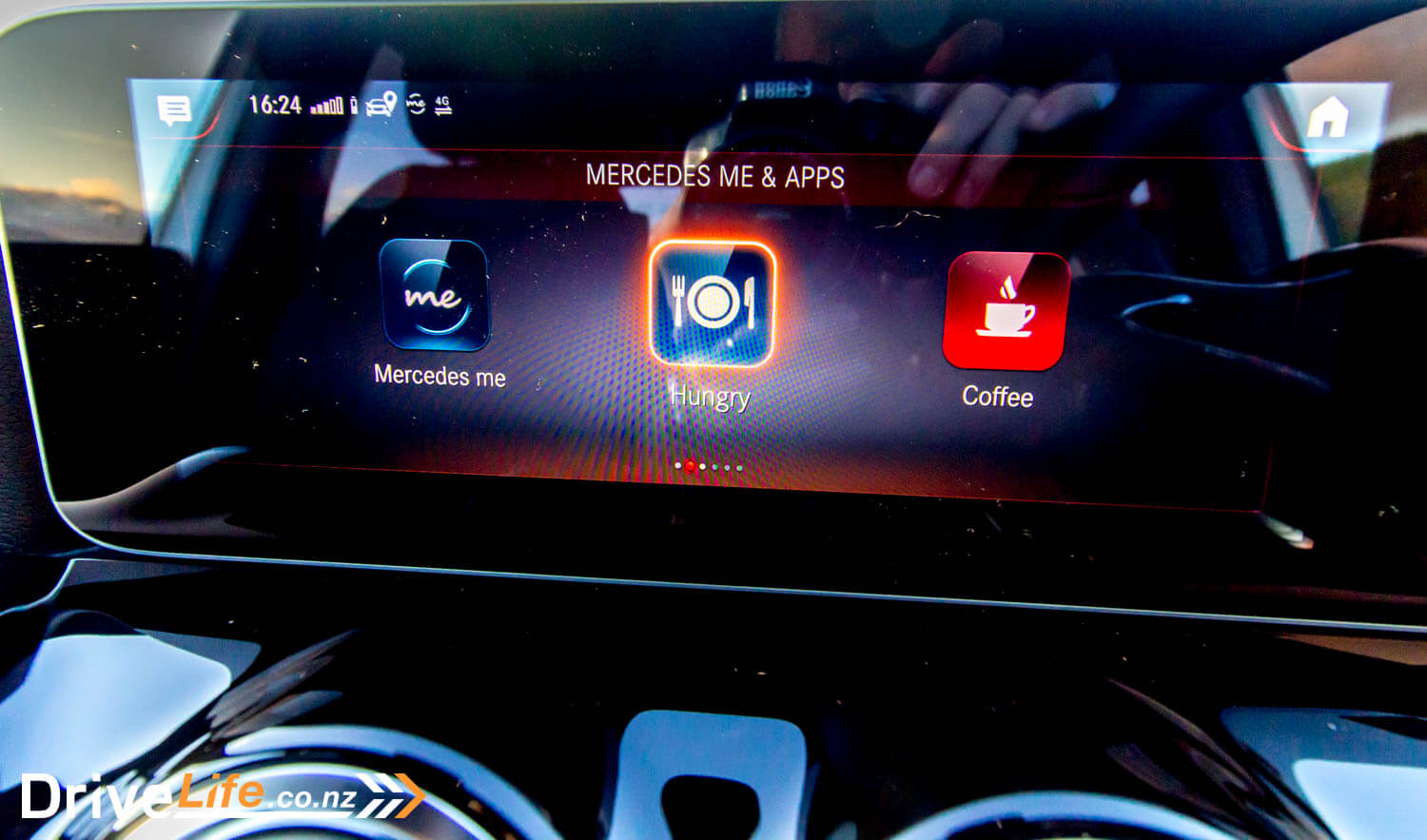
The Mercedes me Connect app also links directly to the vehicle’s service needs and can receive alerts and updates, and also connect directly to a Mercedes-Benz service centre to book a service appointment.
The app can display things like tyre pressures, brake lining condition, brake washer and coolant fluid levels, if things like the windows or boot are open or shut (but you can’t open/close them from the app). You can also check your fuel range, and when service is due.
This was a good first attempt at an app that allows you to check out the status of your B180, but in the coldness that is Turangi in winter, I really thought I’d be able to remote start the car and turn on the heated seats, or at least the AC. The only remote service seems to be unlocking the car. Hopefully the next update of the app will include functions like this.
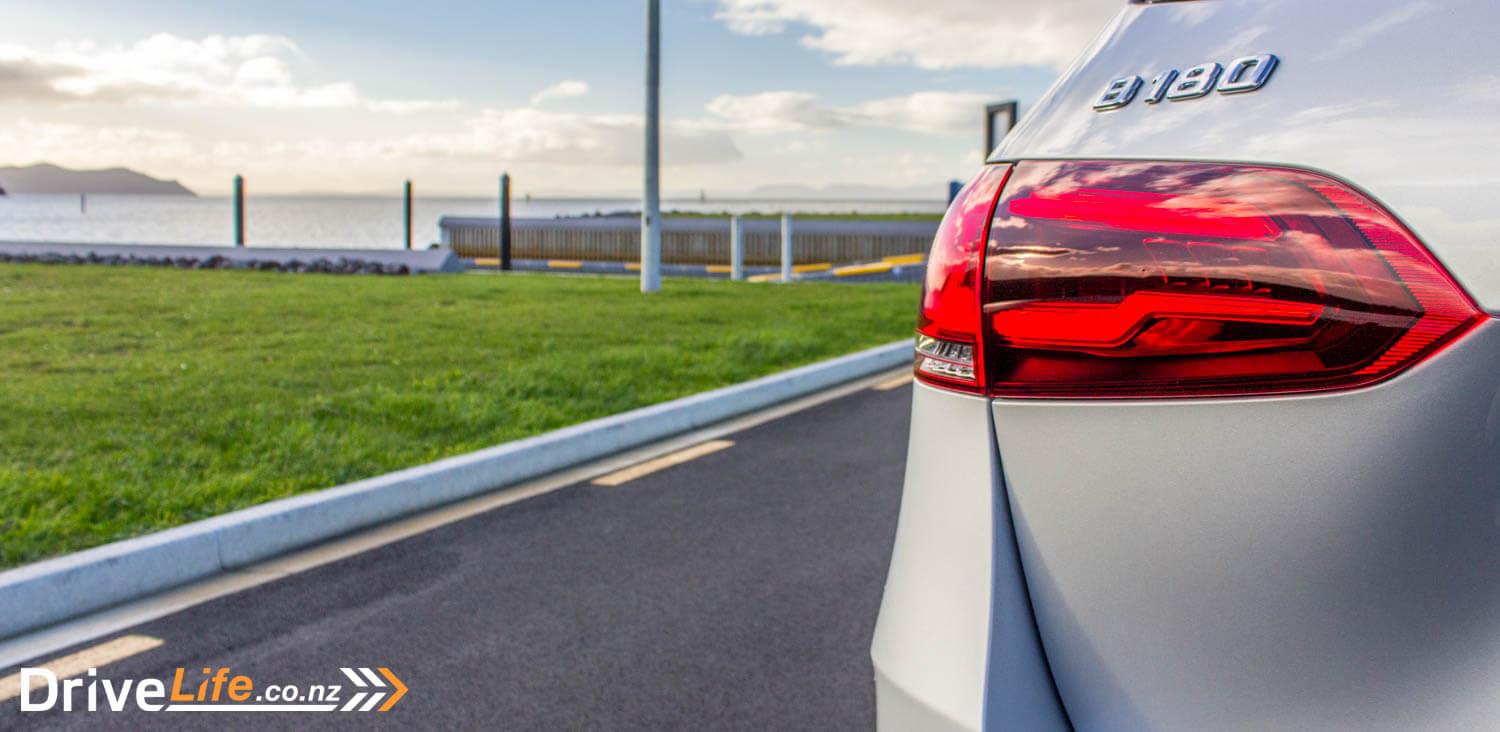
The Competition
| Brand/Model | Engine | Power/Torque
kW/Nm |
Number of seats | Cargo capacity, litres | Fuel L/100km | Base Price – High to Low |
| Mercedes-Benz B180 FWD | 1.3-litre, 4-cylinder turbocharged petrol | 100/200 | 5 | 455 | 5.7 | $57,800 |
| BMW 218i Active Tourer FWD | 1.5-litre, 4-cylinder turbocharged petrol | 103/220 | 5 | 468 | 6.4 | $54,500 |
| Audi A3 TFSI Sportback Design FWD | 1.3-litre, 4-cylinder turbocharged petrol | 110/250 | 5 | 380 | 5.0 | $50,900 |
The Pros and Cons
| Pros | Cons |
|
|
The Verdict
Other than the look of the B Class – which I’m still undecided on – this is a car I could buy. It’s practical without being an SUV, it’s good on the open road over long distance, and it’s surprisingly fun on the corners.
But – and you know what I’m going to say – for me, that DCT transmission is its Achilles Heel. While some cars we test have a fault or something you don’t like, often you get used to it. Not so with the B180. I loved driving it, except when I had to stop, knowing it’d be a jerky start-off again.
Then there’s the Lane Keep Assist that won’t stay off. I must admit, that drove me a little crazy.
The B180 has great potential, but these are two flaws that I just couldn’t live with.

2019 Mercedes-Benz B180
3.5 Chevrons
| Vehicle Type | 5-door, front-wheel drive |
| Starting Price | $57,800 |
| Price as Tested | $62,760 |
| Engine | 1.3-litre, 4-cylinder turbocharged petrol |
| Transmission | 7-speed DCT automatic |
| Power, Torque
kW/Nm |
100/200 |
| Spare Wheel | Pump |
| Kerb Weight, Kg | 1,425 |
| Length x Width x Height, mm | 4419x1796x1562 |
| Cargo Capacity, litres | 455/1540 |
| Fuel Economy, L/100km | Advertised Spec – combined – 5.7
Real World Test – combined – 5.9 Low Usage: 0-6 / Medium Usage 6-12 / High Usage 12+ |
| Fuel tank capacity, litres | 50 |
| Towing Capacity
Kg, unbraked/braked |
N/A |
| Turning circle, metres | 11.0
Small: 6-10m / Medium 10-12m / Large 12m+ |
|
Warranty |
3 years, unlimited kilometre |
| ANCAP Safety Ratings | 5 Star |
